#Also draw your own conclusions from it being in the scene that introduces the main wlw couple
Explore tagged Tumblr posts
Text
So the musical Standing At The Sky's Edge is set in Sheffield, specifically in the Park Hill estate, a large brutalist tower block, and follows the lives of three families living in the same flat in the block over the course of roughly 60 years. (By the by, It's a beautiful and sometimes harrowing show with gorgeous characterisation, incredible staging and wonderful songs by Richard Hawley. I highly recommend seeing it.)
In Doctor Who, Park Hill is also the home of Yaz, fitting given the Chibnall era's home in Sheffield, and this seems like a nice bit of trivia for fans of musical theatre and Who. (Possibly a growing demographic given how much the current RTD era is leaning into West End casts and musical numbers.) All that said...
What I didn't anticipate is that during act 1 of Sky's Edge (after the song 'Open Up Your Door', one of the ensemble at the edge of the stage is dressed as the Thirteenth Doctor and seems to be scanning the set with her sonic!
#Standing At The Sky's Edge#Doctor Who#Thirteenth Doctor#It's an incredible easter egg that I only noticed watching the show for the second time#No idea if it was also the case in the National run or only for the current leg in the Gillian Lynne#Also draw your own conclusions from it being in the scene that introduces the main wlw couple
16 notes
·
View notes
Text
Extracurricular, An Analysis

Oh Ji-soo and Bae Gyu-ri
“Love is the ultimate outlaw. It just won’t adhere to any rules. The most any of us can do is sign on as it’s accomplice.” - Tom Robbins
You know the story. You’ve heard it before, right?
Boy meets girl.
Girl finds out that boy is running a side protection business for prostitutes.
Girl decides to blackmail boy into letting her join his business.
Classic high school criminal shenanigans ensue leading them into more dangerous situations where they are forced to make desperate decisions to stay alive.
Oh, and they fall in love along the way.
Oh? You haven’t heard this one before? Then let me introduce you to this delightful kdrama called Extracurricular.
I watched this one while waiting for the newest Hometown Cha Cha Cha episodes to drop and ended up binging the whole series in two days. There are many remarkable parts of this series: it’s a crime drama, first and foremost, that showcases high school teenagers caught in a cycle of violence and crime, abandoned by the society and adults that are supposed to be protecting them. There are no clear good guys and bad guys in this drama; everyone is cast in shades of grey. Our main leads, Oh Ji-soo and Bae Gyu-ri, run the prostitution business, and are both from broken family backgrounds. Their actions are morally questionable at best, but the top tier performances from Kim Dong Hee (you might remember him from Itaewon Class) and Park Ju Hyun make you cheer for them anyway. You want them to have a happy ending, despite the horrible things they do. The audience is always reminded that despite how clever they are in staying ahead, their actions have consequences, and they’re just high school kids. The drama never pulls it punches.
But, weirdly enough, it’s also a love story. And that’s the part the really sticks with me until now. (The chemistry between the main leads is absolute dynamite and I could watch ten episodes of them just verbally sparring with each other. They don’t even kiss. They’re that fantastic when together on screen.)
I’m writing this because this is undoubtedly one of my all time favorite kdramas and I have a lot of feelings about our main pairing, Ji-soo and Gyu-ri. I can’t call them a couple (wait, didn’t I just say they fall in love) because their relationship can’t be labelled simply as that. Think of it as something similar to the main leads in My Ahjussi. Two people who should have become soulmates, yet met at the wrong time.
This kdrama is not particularly happy, and while I do encourage people to watch this, I am warning that the subject matter is extremely dark. If you’re sensitive to scenes depicting sexual assault, graphic violence, or anything in that zip code you’ll want to steer clear.
Also, I’ll be diving into spoiler territory in this analysis. So if you want to go in clean, then stop reading here.
Still here? Awesome. Let’s dive deep into the messy, amazing pairing that is Oh Ji-soo and Bae Gyu-ri. First, let’s do a brief character background on our two main leads, starting with Ji-soo.
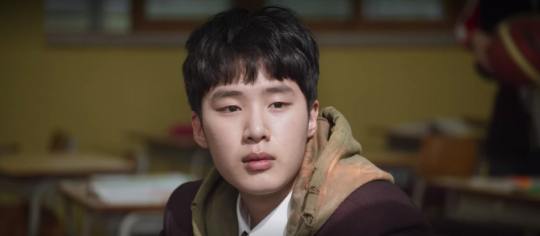
Oh Ji-soo is one half of our main pairing and this story starts with him. He lives by himself and has been essentially abandoned by his only parents; his father is a failed businessman who gambles whatever money he acquires on scams and his mother ran away. His apartment is small, sparse, but functional. He owns only a few outfits aside from his school uniform. The only unique item he owns is a pet hermit crab that he takes care of. His life outside of school is non-existent; he has no friends, no one to hang out with and do typical high school teenager activities with. He takes care of himself and lives only for himself and his “dream”: to graduate, attend college, get married, and have kids like a normal person.
But to do that, he needs a large amount of money. He has no other financial means to do so (his father is largely absent, as is his mother), so he decides, at some point, to start up this protection business for prostitutes. The drama doesn’t go into detail about the how and why he came to this conclusion that this was the best way to make a lot of money in a short amount of time, so you’ll have to suspend your disbelief from the get go. Considering the themes of the story (how youths abandoned by society tend to act out in extreme ways to make it in this world), it’s not hard to believe his desperation would drive him to make such a decision.
Ji-soo, despite his shady business, is actually a decent person. There’s a streak of humanity that exists inside him that refuses to go out, despite the increasingly dark and bleak events that start to overtake his life. He’s attached to his hermit crab, cares for his “employees” outside of them being tools to make him money, and doesn’t want to see anyone get hurt. He goes above and beyond what’s required to help out people at the risk of his own life (in particular, Gyu-ri, and we’ll get into that shortly).
What we learn from the first few episodes is that Oh Ji-soo is extremely smart and methodical in how he approaches his life. At school, he is known as a model student - quiet, top of the class in terms of grades, doesn’t draw any attention to himself, always follows along with what the teachers ask of him. Only his homeroom teacher, Mr. Cho, seems to consider his quiet style of existence to be concerning and tries to make him less socially awkward by pairing him up with another student in a new extracurricular club. This leads to the introduction of Bae Gyu-ri, Ji-soo’s longtime crush and future partner-in-crime.
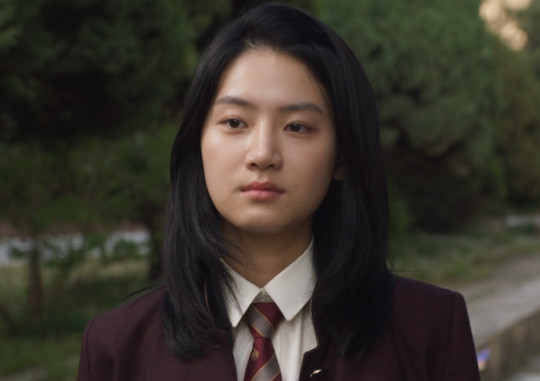
Meet Bae Gyu-ri, the other half of our dynamic duo. Her introduction into the story kickstarts the entire plot, as one of her earliest actions leads to a domino effect that spells increasing doom and tragedy for our main leads. She messes with Ji-soo’s operation at a critical moment and she spends the rest of the drama doing her best to make up for the consequences that follow.
In my personal opinion, she is probably the best main female lead I’ve ever seen in a kdrama. Hands down, no other character exists (currently) that rivals her sheer cunning, wit, and badassery. Gyu-ri is Crazy, capital C, and is the chaos to Ji-soo’s control; the fire to his ice. Despite being the direct cause of half the events that happen to Ji-soo in the drama, he can’t help but need her because of what she offers. They make an incredible team. Her competitiveness, her need to win no matter the odds, helps them survive time and time again.
Gyu-ri is from the opposite end of the spectrum of Ji-soo; he’s dirt poor and she’s insanely rich (always nice to see a reversal of typical kdrama tropes). Her mother and father run a successful entertainment company. Gyu-ri is popular at school, friends with seemingly everybody, pretty, cheerful and gets along well with her teachers. Ji-soo, and the audience, believe from the beginning that she has the perfect life. It’s not hard to believe that she’s just involving herself in Ji-soo’s business because she’s bored and needs an outlet, at first.
We soon learn otherwise. Gyu-ri has more in common with Ji-soo than he initially realizes, in that they’re both trapped in circumstances beyond their control - it’s just that Gyu-ri’s cage is gilded, whereas his is not. Her parents are strict and have her life planned out for her, all without her consent or input, leaving her feeling frustrated and powerless despite her rich lifestyle. A suicide attempt hasn’t done much to change her parents attitude towards her, only serving to further their control over her life.
So, when she learns of Ji-soo’s operation she immediately seeks to angle her way into it. First, she tries to rip him off, believing that he’s an evil “pimp” and thus deserves it. But after spending some time with him, she changes her mind last second and decides to help him out instead.
And, now, let’s get into their relationship, which is one of the best (if not the best) aspect in the entire series.

I need to be upfront about something: the relationship between Ji-soo and Gyu-ri is not exactly healthy. I wouldn’t describe it as toxic - the circumstances surrounding them aren’t exactly the best environment to encourage open and honest communication - but it’s definitely not what should be considered ideal, especially for young adults, and especially for young adults who are dabbling in crime instead of studying.
So, why do I love them so much? If you’ve read some of my previous posts, you know that I loathe toxic relationships in kdramas, so I understand if you think I’m coming off as hypocritical here. Why do I like Oh Ji-soo and Bae Gyu-ri when I didn’t like, for example from recent history, (oh boy, here I go again on my Nevertheless BS) Park Jae-eon and Yu Na-bi?
First, Ji-soo and Gyu-ri are way cooler than Jae-eon and Na-bi ever could be. They run a criminal enterprise that involves having a high amount of intelligence, cunning, and daring to do so. Do Jae-eon and Na-bi run a criminal enterprise as a side business? No, they don’t, because they’re boring art students.
Secondly, Ji-soo and Gyu-ri actually progress in their relationship and change their views as they learn from each other. Now, granted, that progress isn’t towards becoming better versions of each other - quite the opposite. But at least they have progress. Jae-eon and Na-bi stayed in the same stupid cycle for the whole series and then decided that it was better staying that way as opposed to trying for something else.
Last, but certainly not least, Ji-soo and Gyu-ri are actually interesting to watch for me. The chemistry between Park Ju Hyun and Kim Dong Hee is explosive and they way they spar, exchange looks, and just generally exist around each other on screen is something I can watch forever. I’ve said this before but Han So Hee and Song Kang’s on screen chemistry, outside of their intimate scenes, really didn’t impress me.
Okay, back to Extracurricular. This relationship, man. It’s all I can think about (other than HomeCha’s Du-sik and Hye-jin, but that’s another post). Ji-soo and Gyu-ri are so good together.
I’ve noted before that Ji-soo is methodical in how he approaches his life; he plans out everything ahead, and rigs any situation as much as he can in his favor. It’s brilliant, but when a crisis happens, he doesn’t know how to deal with it effectively. He panics and flounders; becomes indecisive at a time when clear, decisive action is required.
Enter Gyu-ri. She quickly becomes the partner he never knew he needed. When there’s a situation, she becomes invaluable in her quick thinking and wit, coming up with solutions on the fly. It’s not perfect, but it keeps them just one small step ahead of whatever is coming their way.
The only thing preventing them from becoming unstoppable is the lack of communication and trust they have with each other. A lot of that has to do with how Gyu-ri entered Ji-soo’s business - she blackmailed him first, and, when that failed, she strong armed her way into getting him to accept her help. It’s implied in the drama that Ji-soo has had a crush on Gyu-ri for a while (since ninth grade, I believe) and in the first episode he actually gets the chance to spend time with her outside of school on a sort of quasi-date.
It goes sideways pretty quickly because of some shenanigans from his business, but not before she gets to know him and says some pretty touching words regarding his situation. Poor guy is head over heels - even after finding out that she’s the one blackmailing him, his feelings are only dampened, not extinguished. When he catches a glimpse of her family’s situation, he gains a deeper understanding of her and why she acts the way she does. Even more importantly, Ji-soo treats her the same after finding out this information which, to someone like Gyu-ri, means more than if he comforted her about it.
If you want to see a physical representation of how he feels, other than paying attention to his actions, you can see it in him keeping mementos from Gyu-ri. She has an interesting habit of folding bags into origami shapes and giving it to him. Even after the blackmail reveal, you can see that he continues to keep these in a container on his desk. It’s really cute that he keeps these, when it probably doesn’t even matter that much to Gyu-ri.
Towards the end of the drama, Ji-soo prepares to turn himself in to prevent Gyu-ri from being implicated in the crimes they committed. And it costs him almost everything to protect her. Ji-soo, the quiet, nerdy kid, puts himself on the line time and time again to protect Gyu-ri, knowing that it puts his life and his dream at risk to do so. And all for what? For some girl that he thinks doesn’t even like him in return?
Well, let’s talk about that. Because I’ve seen some comments that Gyu-ri was only using Ji-soo for her own selfish gain. And I can agree that was how it was at the beginning for her; she definitely was only interested in acquiring money, like Ji-soo was, in order to achieve her own goal of being free from her parents.
But, oh man, that is not what is motivating her at the end.
It’s actually pointed out relatively early by some of her friends that it’s obvious that she likes Ji-soo more than he likes her. Understandably Ji-soo is keeping her at arms length from him given the whole recent blackmailing, so it would make sense that it looks that way.
Further questioning reveals what she likes the most about him:
“It’s not like I’m crazy about him. He’s fun. And amusing. He’s smart. And there’s a certain charm he has. He also has a wolfish side to him. But he thinks he’s a puppy.”
- Bae Gyu-ri
But, as she gets to know Ji-soo better, you can certainly see that she starts to fall hard for him. As a cover story for why they hang out so much together during and after school, Gyu-ri states to everyone that they’re dating. The reactions across the school definitely imply that this is a shocking development, which means that Gyu-ri hasn’t dated anyone before. So why Ji-soo other than the reasons she herself states?
He challenges her, just as she challenges him. Gyu-ri may be the more dynamic, quick thinking of the pair but Ji-soo is every inch her intellectual equal - just in different ways. She doesn’t seem to be the type to be easily impressed, but you can tell that she’s definitely impressed by Ji-soo’s operation and how thoroughly set up it is. When Ji-soo is frustrated at the beginning by his setbacks, he blows up at another student (knocks him out in a crazy punch) and immediately walks over to Gyu-ri afterwards (who saw the whole thing) to inform her that she is now his partner in crime.
The look in her eyes, and the small smirk she has speaks volumes about her attraction to him in that scene. Smoldering.
And, oh yes, she’s prone to jealousy. Another classmate, Min-hee, gives Ji-soo a present out of the blue (it was supposed to be for her boyfriend, Ki-tae, but that’s another sub-plot) - all within view of Gyu-ri. It’s hilarious how she tries to brush it off. Later, for plot reasons, Ji-soo has to spend more time with Min-hee which only furthers Gyu-ri’s annoyance.
And her motivations stop being entirely about the money and more towards helping preserve the dream that she and Ji-soo share about being free. There’s a scene in episode 8 where it’s revealed that, due to a business partnership with a local gang (set up by none other than Gyu-ri herself in a desperate move), Ji-soo would have to drop out of school permanently to work on their behalf. Gyu-ri overhears this and, despite badly needing the gang’s help in sustaining their own business, immediately terminates the partnership.
All because it would interfere with Ji-soo’s dream.
Man, if that isn’t love.
In the following episode, Gyu-ri, and later on Ji-soo, is kidnapped by the same gang in retaliation for terminating their partnership. Ji-soo comes to her rescue but Gyu-ri is already almost free (again, she’s really, really badass) and is demanding that they bring Ji-soo to her instead of running for her life.
Surviving this latest attempt puts the two in a reflective, vulnerable mood and Gyu-ri asks Ji-soo why he keeps saving her. Ji-soo asks later on why she keeps risking her life to be with him. They don’t say the answer in words but in an almost kiss (yeah, you read that right - almost).
And then, if you aren’t already convinced, Ji-soo crosses his one last remaining line in an effort to keep Gyu-ri safe; he accidentally pushes a fellow classmate down some steps and, instead of helping her, leaves her to die after grabbing the evidence she has on him and Gyu-ri.
Extracurricular pulls off quite the magic trick here, hiding this well done love story in the middle of a serious crime drama.
The real tragedy is that Ji-soo thinks that Gyu-ri views this whole business, and by extension his life, as one big game. It’s something that she takes offense at, visibly becoming upset when he says that.
But even if that were true, he should be assured since Gyu-ri doesn’t like to lose.
As they hurtle towards the end and face up to the consequences of their actions, Ji-soo and Gyu-ri undoubtedly lose sight of their original goals and dreams. They do some fairly horrible things to stay alive and ahead of the police who are close on their trail. You can’t really blame them for doing what they did; in the face of a society that has abandoned them, what they’re doing is a logical outcome to gain what they want so desperately and deserve so much: the chance to be free to live like normal, care-free people.
I can’t say for certain that they achieve that. The drama is serious in consequences and, at the end, the net around them is drawing tighter and tighter. I won’t spoil the ending scene for you, because I highly encourage you watch this drama yourself but I will say this: Ji-soo and Gyu-ri seem stuck in an impossible situation with nowhere to go, and no one to help them, with a clock ticking down towards either death or discovery by the police.
But, all the same, I’m always the optimist. They’ve gotten through situations like this before and they can certainly do so again. Maybe not as bad as this one, but not too far out of their league. And, like I mentioned before, Gyu-ri doesn’t like to lose. Especially when it comes to Ji-soo.
Their relationship is truly dangerous, as Ji-soo himself notes. Them being together is the source of their problems; they’re too much alike now, as opposed to the beginning of the drama where he stated that they’re too different. Their love is the kind of love where both of them are willing to burn the whole world down if it means keeping each other safe.
I’m a real sucker for those kind of love stories. No one’s a hero here. They’re just kids in high school, doing the best with what they know.
Who are we to judge what is right and wrong? Especially when the one committing the acts are high school kids who don’t know any better and just want to save each other?
Do we have that right?
Do they really deserve that punishment? Shouldn’t we be pointing fingers at the society that forced them to act this way?
Extracurricular really makes you think about that. Is it really so outlandish and terrible what Ji-soo and Gyu-ri do to survive when the adults who are supposed to be protecting them, teaching them better, have failed in their duty?
Maybe they really did win at the end. Not so much in succeeding in their goals but in gaining something that not even regular people are likely to find - a partner, a soulmate, someone who will stand by you no matter what.
If you do watch the ending, and are not an optimist like I am, then all I can say is this: whatever happened, they were together at the end.
They were together.
#extracurricular netflix#human class#netflix#kdrama#oh jisoo#bae gyuri#park joo hyun#park ju hyun#kim dong hee
62 notes
·
View notes
Text
“Cerebos: The Crystal City” Actual Play Part III: The End
This is the third and final entry in a series of posts recounting a session of actual play from Cerebos: the Crystal City, currently crowdfunding on Kickstarter. The first two parts can be found here:
https://tumblr.penguinking.com/post/646498084013195264
https://tumblr.penguinking.com/post/646788426842128384
This session was conducted on March 20th, 2021, with Matthew Dorbin as GM, and Amelia Gorman, Ashley Flanagan, Will Mendoza, and Kevin Snow playing. The events of play were recorded by Zach Welhouse.
The First Leg of the journey has ended, and the Lady in Blue is the Seeker. She remembers her past: she was a small-time crook who left the City by the Sea to kill her murderous, thieving sister. Having pieced together her past, she has until arriving at Cerebos to decide if she still wants to kill the Lady in Red.
The Unqualified Robot, Tinderling, and the Lonesome Seafarer won’t find the answers they were looking for in Cerebos. However, they’ve ridden the rails with the Lady in Blue long enough they may have learned something else. Aiding her in her journey may clarify their own futures.
Tinderling and the Unqualified Robot hope the Lady in Blue will kill her sister. Actions have consequences and violence is sometimes necessary to restore balance. The Lonesome Seafarer has had enough pain. She hopes the Lady in Blue will be able to move on – or find common ground with the woman who did her wrong.
Sixth Round of Train Actions
Tinderling notices an enormous marble building in the distance. From its Greek pillars and statues of Justice, it’s probably a courthouse. None of the travellers are on especially great terms with the law, but the train stops anyway. This journey isn’t just about them. There are other passengers too! A trial is in session when the passengers arrive, and it requires four jurors. As outsiders, the travelers are unbiased. Wigged functionaries encourage them to attend the day’s arguments. It’s the trial of Hodur, Norse god of winter and accidental murderer of Baldr. Baldr is testifying when the jury enters: “My death was absolutely necessary! My death was all part of a larger plan!” He cites Romulus & Remus, Osiris & Set, and other famous examples of fratricide. Sometimes a death is necessary for the greater good.
Tinderling’s player spends 1 Momentum to create a Danger 2 Stop as a Saintly Revelation. She doesn’t want to make the journey to Cerebos more difficult for anybody, but she does present the Lady in Blue with an argument to stay the course.
As with the previous Stop, the other travelers should have received a Train Action before arriving at the courthouse. The GM had been keeping an eye on the clock and made an executive decision to ensure the trains kept running on time. The whole session, including several snack breaks, fit into a four-hour session with only fifteen minutes of overflow!
Stop Actions: The Trial of Hodur
The Unqualified Robot has decided to Seize the Opportunity to divest itself of its past wares. It is defined by actions now, not junky gadgets. It offers gadget after gadget from its backpack to passing barristers, seeking some way to communicate. It rolls a Success and scores a giant foam finger with “FRATRICIDE” written on it. The new jury is fitting in with the trial, so the Danger reduces to 1.
The Lonesome Seafarer waits for a lull in the trial and vaults out of the jury box to cross-examine Hodur: “Did you mean to kill Baldr?” She rolls 1 + 5 = 6, but spends a rank of Tunnel Vision to really focus on the heart of the matter and eliminate all obstacles. The rerolled 1 becomes a 5, netting the Lonesome Seafarer an Inspired Success -- and one Momentum to her authoritative hat for rolling doubles! Hodur begins to weep under the incisive questioning: “I could never have done it if I had known! Even if I had to for a better future, I couldn’t kill my brother!” The Stop Danger is reduced to 0. Had Tinderling paid an extra Momentum while setting up the Stop, the Unqualified Robot or the Lonesome Seafarer would have received a keepsake for their efforts.
Tinderling, disgusted by Hodur’s breakdown, starts carving something rude in the juror’s box with her bird bone sewing needle. She’s learning that she’s really into this justified violence thing. How come these people don’t understand progress is impossible without sacrifice? She rolls to Release the Touchstone – a symbol of peace – and succeeds. The needle snaps. She burns with clarity and gains one Contemplation.
The Lady in Blue isn’t in danger. She rests, shakes hands with a few visiting gods, and loads up on jury cookies. She removes one Momentum.
The court is in an uproar over Hodur’s outburst. The travelers aren’t interested in being further embroiled in someone else’s problems, so they sneak out back and return to the train.
Sixth Round of Train Actions (Continued)
The Lonesome Seafarer triggers a Revelation to counter Tinderling’s full-throated endorsement of fratricide. Two high-pitched voices begin shouting from the next car: “I hate you! I wish you weren’t my sister anymore!” The fight spills over into the travellers’ car as two six-year-old girls shove and cry into each other. It’s a Danger 2 Event demonstrating that just because siblings fight doesn’t mean they have to be enemies.
The Unqualified Robot triggers its Saintly Revelation. Since leaving the courtroom, it has been busy building an effigy – a new sibling – from its unsold junk and extraneous body parts. If it can’t communicate with people, maybe something closer to its temperament will do the trick. Calamity strikes! After a disagreement, the Robot and its twin begin to fight. Encouraged by the violence they’ve recently observed, it escalates. Presumably the twin was at fault. The Robot’s player explains, “I think the moral here is the danger siblings hold and how they must be destroyed.” The Robot Battle Event is Danger 5, threatening to strip the train to its bones. Luckily, Cerebos is in sight!
Since the Saints and Demons have introduced their Revelations, it’s time for the Endgame. Cerebos arrives! Its towering spires of crystal and neon illuminate the night. Squabbling siblings, a pair of robots engaged in an all-out hurly burly, and passengers who have begun to take sides pour from the train, attracting the attention of a number of station agents armed with stern frowns and truncheons.
Normally, the gates of Cerebos are a Danger 2 Stop, but the unresolved Events from the train boost it to a worrying Danger 4.
Stop Actions: The Gates of Cerebos
Tinderling stands on a barrel and fans the flames of animosity, pulling unrelated passers-by into the fight: “Hey! This is what happens when you have an evil twin. Monsters are monsters and they don’t change!” She Causes Trouble to boost the Stop to Danger 6 and extend the scene. Everyone receives an extra cycle of Stop Actions.
The Lonesome Seafarer also trusts her words to address the growing riot, arguing for peace. She draws on the harsh lessons she learned from Scurvy, her missing mate: “You have to give people a chance to change!” It’s like shouting into a storm. Fists and rocks fly as she takes Damage, her words unheeded.
The Unqualified Robot briefly breaks free from its apocalyptic struggle with its evil twin. These… emotions are just holding it back. It tries to Release its last remaining expression slide, a smiley face defaced by angry eyebrows. An Ugly Break. Communication is easy when it involves throwing things. It gains Momentum on its whiskey flask and gains Contemplation. It thanks Tinderling for introducing the path of rage.
The Lady in Blue lays into the fray with elbows and right hooks, clearing people away from the Unqualified Robot. They’ve shared whiskey. Everyone just needs to stand back. She takes Damage and reduces the Danger to 4.
Tinderling is taken aback at the chaos she has unleashed. It was all going so well, but the Unqualified Robot is taking a lot of hits. It’s burning too bright! She Seizes an Opportunity and starts laying into station police and onlookers alike. Even spending Burns at Both Ends to flare up like a hero, she takes Damage to reduce the Danger to 3.
The Lonesome Seafarer pushes through the thinning crowd of combatants to the main event: robot vs. robot. She engages the evil twin with watertight logic and the Coat of Thesus Trait: “That robot is made out of your same parts! Why would you fight yourself? That’s not fratricide. That’s suicide!” After a string of unlucky rerolls, she ekes out a Partial Success, taking Damage while wrestling the Evil Twin off the Unqualified Robot. Danger 2.
The Unqualified Robot scrambles back, throwing everything in reach at its evil twin: unsold junk, garbage, rocks. It’s not enough. The only way to end this is to carry its actions to their logical conclusion. The Unqualified Robot tears off its head and flings it at the effigy. The effigy, stunned by the extreme act of violence (and the high-velocity assault) explodes. Danger 1.
The Lady in Blue needs a moment. Watching her travel companion tear off its head to kill its sibling is a lot. Battered passengers and station police slink off. A siren wails in the distance. The Lady in Blue turns to the squabbling children from the train, who stayed focused on one another the whole time the battle raged around them. “Kids. Let’s talk. What happened?” she asks. The sisters explain a very long, very important story that involves teasing and boysenberry (or possibly poisonberry) tea. It is ridiculous. The Lady in Blue sighs long and deep. “It’s not like I’m not already headed to Hell. Try this, kids. This is what real poison tastes like.” She offers them each a sip of whiskey, transferring their animosity to her as they taste the rough, foul drink. Two-vs-one isn’t fair, but the Lady in Blue weathers their coughing and shin-kicking. Failure. The Lady in Blue takes stress Damage and the round ends: “I solved a fight between two children and I feel terrible about it.”
Epilogue
Tinderling, the Lonesome Seafarer, and the Lady in Blue walk the backstreets of Cerebos. They don’t glisten with empyrean light like the main thoroughfares, but neither are they patrolled by gendarmes searching for whoever it was who started the brawl at the train station.
The Lady in Blue takes out her revolver, spins the cylinder, and stares down the barrel. She pops out the last bullet, sheathes her gun, and leaves her fellow travelers. She has chosen the Devil’s Path, deviating from her initial goal thanks – in a strong part – to the tragic brutality of the Unqualified Robot.
Everybody looks at their goals, laughing at the fresh round of revelations. The only thing left to do now is tally up Momentum and Contemplation to make epilogue rolls.
The Unqualified Robot died doing what it loved: throwing something. The end. No moral.
Tinderling is a member of the Walking Wounded, unable to settle down in Cerebos, which seems just as bad for workers as the City by the Sea. Nevertheless, she’s gained a newfound appreciation for robot rights. Before leaving for Cerebos, robots were machines, jerks, and scabs to Tinderling. But the Unqualified Robot taught her that treating robots like tools would only lead to calamity. Maybe her redemption lies in solidarity with all workers...
The Lonesome Seafarer’s epilogue roll is similar to Tinderling’s. Scurvy isn’t in Cerebos, but she’s found moderating influences elsewhere: “That robot ripping its own head off has taught me some valuable things about myself.” She still hopes to find her missing mate someday, but it isn’t quite the obsession it once was. In the meantime, she’ll keep traveling.
The Lady in Blue rolls a 4: Self-Actualization! She acknowledges the wrong the Lady in Red did to her, but finds peace in putting aside revenge. She’ll live her own life, not one controlled by a further descent into bloodshed. Strolling the streets of Cerebos, she sees Tinderling passing out leaflets and the Lonesome Seafarer inspecting a ship-in-a-bottle in a shop window. She feels a fondness for the Lonesome Sea Captain, perhaps from the adventures they’ve had or perhaps because it was she who first directed the Lady in Blue to Cerebos. “Captain,” says the Lady in Blue, taking the captain’s arm. “How do you feel about having a whiskey with me?” “I’ve only had grog before,” the Lonesome Seafarer hazards. “I think you’ll be pleasantly surprised.”
The Lady in Blue and the Lonesome Seafarer walk through the electric streets, arm-in-arm, in search of drinks.
#gaming#tabletop roleplaying#tabletop rpgs#cerebos#kickstarter#violence mention#food mention#alcohol mention#death mention
88 notes
·
View notes
Note
Wait wait wait tell me about Tales of Arise
The shortest answer is that Tales of Arise is a video game, the latest in the "Tales of" series, which, like Final Fantasy, has shared themes and elements and a few sequels and crossovers but typically has each game with a new cast on a new planet, living out a new story.
Now, here is an answer with a little more story and meat.
The world(s) of Arise are the twin planets Rena and Dahna. 300 years ago, the Renans who have both the magic and the technology because life is unfair invaded and conquered Dahna, and enslaved the populace. Now Dahna is divided into 5 realms, each ruled by a Renan Lord (and the lords can be female) who is armed with a Master Core--an extremely powerful mystic artifact, you know the type--linked to the element their realm is associated with. Each generation, the "Crown Contest" is held to decide which of the five reigning Lords will become the next Renan Sovereign, based on the amount of “astral energy” extracted from Dahna's population and environment (see the magical potential lives in the Dahnans too even though they supposedly can’t wield it and just house it) stored in the Master Cores in each Lord's possession.
With me so far? Now let’s meet our heroes.

Alphen, a Dahnan slave locked in an iron helmet (for what infraction nobody knows) who doesn’t remember much of his past--and, in fact, at first doesn’t even remember his original name and is just called Iron Mask. He is a SWEETHEART though even though he looks like he should be the “edgy” protag type when dressed in the dark armor that is his main outfit...well, his main outfit for those who haven’t unlocked the ability to dress him as a farmer or a in a towel and put bunny ears on him. The mask slowly breaks and chips away and I won’t say it’s symbolic or linked to recovered memories and him emotionally opening up but you can draw your own conclusions. It also allows him to wear a "judging you" face.

OH AND ONE MORE THING. Alphen cannot feel pain, again for reasons he doesn’t know. This is presented with drawbacks semi-realistically shown such as not realizing when he is injured or to what extent sometimes.
Our story kicks off when Alphen meets Shionne. Renan hunted by her own kind because she stole one of the master cores (and maybe not just for that). Tough, spirited, gorgeous, and also a sweetheart once you get to know her, she has her own agenda I won’t spoil but she is a traitor to her own kind who plans to steal all the master cores and kill all the lords--freeing slaves being more of a side effect than a goal at first.
Shionne was also born under a curse where anyone who touches her is caused extreme pain, making her real touch starved and lonely, so lucky she ran into the one person not effected by it.
That is literally just the beginning, only scratching the very surface of the two leads and not even introducing our other party members
Rinwell, (baby girl, baby, but also full of justified dark resentment toward Renans) a Dahnan who proves that whole “Dahnans can’t perform magic” thing false and who has a pet baby owl named HOOTLE that lives in her hood.

Law, another Dahnan, introduced as someone who sold out and reports on his fellows/helps the Renans enforce because that’s what you do to get by.

Then these two, Kisara and Dohalim, who show up to trigger some bisexual awakenings.

They have some great backstory too, but, you know I need to just sling some jokes before I ramble too much. That’s your intro. More details can be given upon request.
Great story, even if, like many JRPGs, you have to meet the story halfway and fill in a few holes in the third act or resign yourself to "it gets a bit confused"
Great characters and designs.
Good mix of serious and then silly breather scenes and hot springs trip sidequests and space aliens.
8 notes
·
View notes
Text
Introducing: the girlfriends — Lace
Hello cherry blossoms!
Since the girlfriends will feature as original characters in some of the pieces I’ve planned, in this small serie you will find some general information about the girls, presented with their aesthetics. Here you will find Taehyung’s Lace. She will also be featured, together with Princess, in the next piece so I think this introduction will help you get acquainted with her as a character.
NSFW material included. Read at your own risk.
Here you can find my masterlist :)
Enjoy!!!


Lace is a lady through and through. She is tough and elegant, apparently cold but extremely affectionate with those she loves. She is close friends with Vixen. During her university years, she was Princess’ flatmate, even though they got out of touch because of Princess moving out of the neighbourhood and both of them getting really busy with their jobs.
Just like Princess, Lace too works in the fashion industry, more precisely she is a shop assistant — soon shop manager — in a store of an extremely famous and expensive brand of lingerie. She is also a skilled tailor and has her own lab where she makes customised lingerie: she dreams of it becoming her main occupation someday. She is maybe the same age as Taehyung or a couple years older.
In terms of physical appearance, she is curvy and quite “fleshy” — imagine a diva from the Sixties like Liz Taylor or Sophia Loren. She perfectly knows how to wear her curves, chinching her waist and pushing up her breasts in tailored corsets and bustiers, however she is often dressed up in pretty and elegant vintage style, complimenting her sinful physique in classy and modest outfits. She most definitely has love handles and round, soft hips: her body is the definition of femininity and she struts in it like a model. Her confidence is what makes her look so sexy, even if society might not approve of her body.
Taehyung has a very soft spot for her body; he loves the feel of her under his fingers, gripping her flesh. He loves the texture, consistency and the concrete materiality of her, her body making her look like a diva (and totally his wet dream) but also feeling so real and carnal.


Lace and Taehyung are basically a real life example of Gomez and Morticia Addams. They’re passionately, foolishly, sinfully in love with each other. He worships her like a goddess and follows her with heart eyes like a tail-wagging puppy. Lace might look like a cold minx, but behind closed doors she literally adores him, in every possible way.
Taehyung fell for her with a coup de foudre — as if struck by a lightning — literally love at first sight. Lace was more wary about her crush: she takes it easy because she is awfully afraid of the intensity with which Teahyung entered her mind and her soul, and she hopes that such power is not a spur-of-the-moment kind of thing.
Their dates include mostly art galleries and parks, but also old movie marathons, which she watches for fashion inspiration and for their dreamy romance. During said marathons, they lay side by side, with Taehyung’s hand toying with her hair, and Lace’s nails gently scraping against his nape. Sometimes they watch a film they have already seen so that they can make out without missing out on anything. Expect romantic getaways. Lots of them. Taehyung loves big European cities such as Paris, London, Amsterdam and Prague, and Lace likes following him whenever she can, enjoying a few days of art and food and steamy romance.
They are not afraid of being affectionate in public: at the beginning she is a bit shy and cold, but as she gets used to continuous public exposure, she grows more comfortable and daring, indulging Taehyung in his very public gestures of affection. He often places his arm around her waist, leaning down to whisper things in her ear, exchanging flirty smiles with her and comfortably placing a kiss on her lips every now and then, though I think they leave more thorough tongue tango for the bedroom. Yes, they are king and queen of making out, and if they’re tipsy enough, they would most definitely do that in front of friends and acquaintances, not really caring about by-standers.
Taehyung is her little cuddlebug, hugging her and rubbing his face against her chest whenever he comes home after a bad day. He likes it when she scrapes his scalp gently, as if petting a cat, and when she tuts at him because he’s tickling her with his hair. Her affection is often very sensual, with nails drawing patterns on his naked skin, always trying to get beneath his clothes, where she can feel his warmth and the goosebumps she causes with her touch. On the other hand, Taehyung can be extremely playful and innocent in his affection, drawing every feature on Lace’s face with his fingers, kissing her head and rubbing his face against her chest and neck to feel her skin against his lips and the peculiar scent of her perfume. He gifts her a lot of presents, from small inexpensive ones to extremely costly items — yes, you can guess what they are.

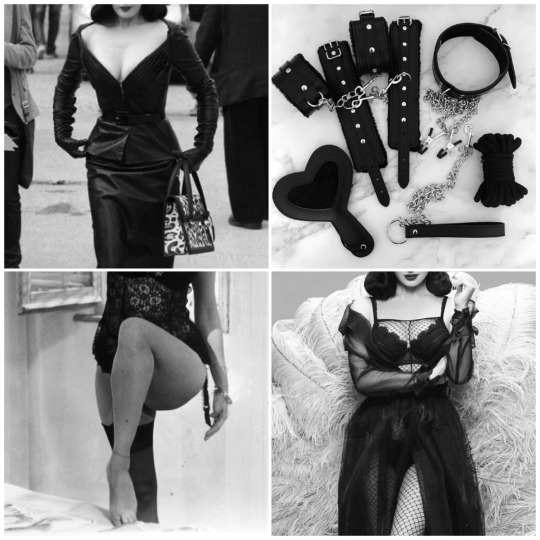
Lace is Taehyung’s girlfriend and lover — she perfectly embodies the duality of a refined, confident lady, and the kinkiest freak in the sheets — giving him the love and support of a relationship and the sinful desire of an affair.
She is a domme. During her university years she went through hard times which brought her closer to the BDSM culture. Through learning dominance and discipline in fields like bondage and sadomasochism, she gained strength, maturity, self-esteem and confidence. Her aplomb and savoir faire attract Taehyung immensely, and he gladly lets her take control every now and then; however since their very first encounter, Lace felt something change within her when she was around him, and her sudden willingness to yield to Taehyung made her realise that he was a man she’d gladly be submissive and sell her soul for. Even though there’s not much power imbalance between them, they do partake in extremely daring practices, involving principally sensation play and various forms of bondage, but occasionally also impact play. They experiment with several varieties of sensations, from temperature, to tickling, to pinching and grazing. Their tactile dimension is very strong, and both like focusing on touch during foreplay and intercourse, which often leads to blindfolds or making love in a completely dark room. On the other hand, they both enjoy watching and being seen, in a magnificent combination of voyeurism and exhibitionism. It isn’t rare for them to sit at the opposites end of the bed and masturbate in front of each other. Their "blind" sensorial explorations and their openness have removed shame from their relationship — Taehyung's extremely thorough perlustrarion of Lace's sensitive body allow him to play her like an instrument with sage, talented fingers.
Lace likes showing her submission through blowjobs, especially with Taehyung standing on his feet while she’s kneeling before him. Taehyung likes tormenting her with long edging sessions before making her come undone round after round, with his fingers, mouth and cock. He especially enjoys wrecking her, using her toys to stretch her out, but also making her cum before he enters her, enjoying her tightness after an orgasm. He experiments without prejudice, sometimes improvising extravagant tricks to turn her on in some genial way. He is ruthless, but also fully and recklessly devoted to Lace’s pleasure, his only goal seeing her spent and naked on his sheets, possibly with his length still sheathed inside her. No matter how harsh or soft the scene, their ultimate goal is the sense of unity they feel once they’re done and ready for a nap or for sleep. Napping while cockwarming is a must: they won’t stop until they’re completely spent and once they've finished, they simply lay there, looking at each other, exchanging small kisses and feeling like one single soul without a body.
Taehyung sleeps thrown all over Lace and although at the beginning she’s not entirely comfortable, especially since he’s a furnace in his sleep, after a while she gets used to having him cuddled into her side, pushing his face into her neck and hair while his arm and leg are wrapped around her middle and her hip. And for the problem of being too hot, well... She just forgoes clothes. Which is extremely useful when he wants to wake her up with his mouth around hr nipple. Or between her legs.
In conclusion, Lace and Taehyung are a very passionate, vey intense young couple, whose relationship is based on an attraction that goes beyond looks and digs deep into the very essence of their character, reaching an almost religious devotion and sacred adoration. Taehyung is charmed by Lace’s magnetism and composure, while Lace is deeply enthralled by Taehyung’s consistent and reliable admiration for her. A satisfying sex life is perfectly matched with the quiet way they show each other support, but most importantly by the way Taehyung’s introspection and artistry plunge into Lace’s sensitivity, showing her a level of understanding she has never felt before. They’re both highly sensitive to the other’s emotion and this spiritual connection, put together with the physical one, offers them a sense of unity that makes them comfortable and completely open to each other.
#introducing the girlfriends#Introducing lace#bangtan smut#bts headcanons#bts blog#Taehyung headcanons#Taehyung x reader#Taehyung smut#Kim Taehyung
52 notes
·
View notes
Text
Shōnen Anime Through The Feminist Lens
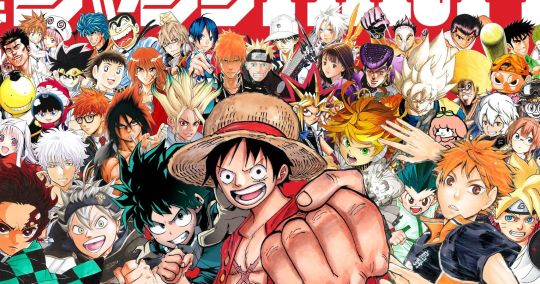
During quarantine, there has been a significant rise in the popularity of Anime; this wave of new fans brought back memories of when I first started exploring anime and how I came to love this media. Anime is a confusing word: In the western world, anime a separate genre of animated shows and movies from the typical western cartoons (ie. SpongeBob, Tom and Jerry, etc.) while in Japan, it refers to any animation in general. But for the sake of simplicity, I will refer to anime as a type of animated show or movie that uses signature aspects of Japanese-style animation.
Usually, a person is recommended mainstream shows from the shōnen genre when introduced to anime. Shōnen anime and manga are marketed towards boys between the ages of 12-18, but a lot of people outside of that demographic enjoy this genre as well. I find myself watching and recommending shōnen shows because of how exceptionally written the plot, the character development, and worldbuilding are. However, problems with female representation stem from the misconception that shōnen is only for boys or that girls don’t enjoy these types of stories. It is frustrating to see how little action and development female characters are given compared to their male counterparts and how often they are sexualized for the sake of comedic relief or fan service.

NARUTO and NARUTO SHIPPUDEN
The Naruto series follows the journey of Naruto Uzumaki as he achieves his dreams to be acknowledged by the village he lives in and become the Hokage (the leader of the village). It’s a story about saving the world, protecting your loved ones, and believing in yourself.
Almost every person who has watched more than 3 years of anime has seen Naruto; those who haven’t still can recognize characters, references, and general plot points. Yes, it is THAT popular. I knew about the show but, I put off this anime for so long because of the silly reason that Naruto was an annoying brat at the beginning of the series. It took me a few months to build up my courage to pick up the series again— and wow! I was glad I did! I restarted my journey about two months ago and, as of today, I have less than 50 episodes left to watch to finish the series (keep in mind that the complete series has about 700 episodes). I got attached to the characters for their development and their compelling stories. I saw Naruto grow from being a troublemaker to a dependable hero, watched Sasuke go down a dark path for the sake of revenge, and learned about Kakashi and Itachi’s heartbreaking childhoods. But the girls? Where are the girls?
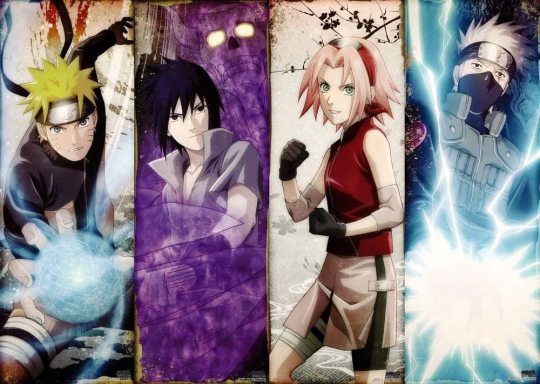
As well written as the story is, girls in Naruto are viewed as support-type characters for the boys; their stories aren’t touched upon and remain the same throughout the series. The lack of development of the girls is best highlighted by Sakura— the main female character and the most hated person from the series, and dare I say, all of anime. At the beginning of the series, Naruto, Sasuke, and Sakura train together to become ninjas with their teacher, Kakashi. Sasuke was a prodigy and excelled in every task, Sakura was known for her intelligence and chakra control, and Naruto lacked skill yet impulsively charged headfirst towards his enemies. As the show went on, Naruto and Sasuke’s skills have grown on par as they continuously try to learn new powers to one-up the other. But Sakura stayed the same. Even though she gained super strength and trained to become a medical ninja under the Fifth Hokage, her abilities and progress are constantly shadowed by her teammates' flashy powers (look at the picture above). This gap is even more prominent after the time skip in Shippuden where she becomes a “damsel in distress” which annoyed a lot of fans. She had so much potential to become a great character. Even if she was not the strongest ninja, the show could have taken steps to make her valuable in some way even if all they did was make her an efficient support character to Naruto and Sasuke instead of making her seem like she is always in their way. The unbalance caused by the lack of active female roles in Naruto leaves the female audience unrepresented. The female characters' underdevelopment implied that the girls are incompetent and therefore don’t get to make an impact in the story.
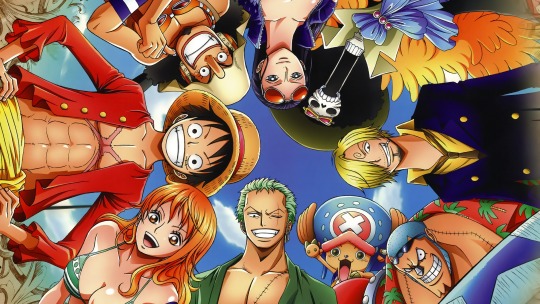
ONE PIECE
I can talk about this show for hours. With 950+ anime episodes and 1000+ manga chapters, One Piece is synonymous with art; it follows the story of Monkey D. Luffy and his crew, the Straw Hat Pirates, on an adventure to find One Piece. Unlike other shōnen stories, One Piece immerses the audience into a mysterious world that is complex, dynamic, and feels real. Every single character is well developed— each of them have insanely detailed backstories, memorable personalities, and compelling motivations making them feel human. The story also tackles unconventional topics such as slavery, racism, the justice system, and classism. I could go on and on listing reasons as to why I love One Piece or why it is worth catching up to the 950 episodes, but I feel like you should let One Piece in and find that out for yourself.
Unlike Naruto, women take on significant roles in One Piece and are often admired as role models. However, the lack of body diversity and the over-sexualization of the female characters leave a rather unpleasant aftertaste.
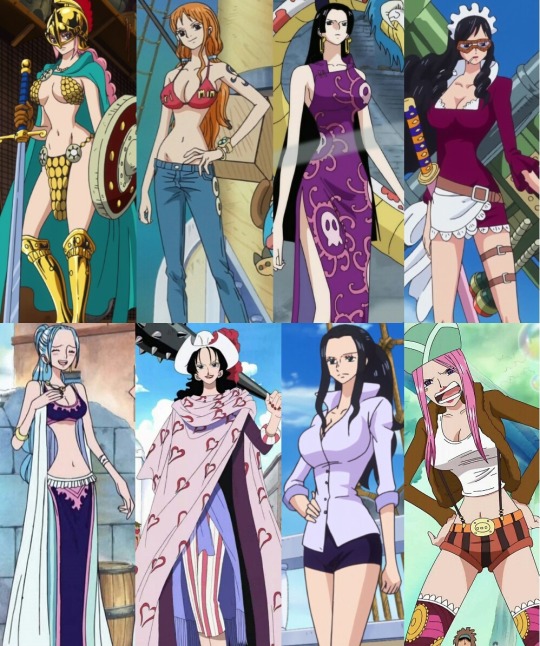
As seen above, they all suffer the same-body syndrome— large breasts, impossibly tiny waists, and skimpy clothing. I get that these are common types of fanservice but, there are plenty of questionable design choices whenever fanservice is prioritized over logic (ie. the top-left girl is supposed to be a gladiator but her outfit does the very opposite of protecting her as it leaves her vital areas exposed). Another issue I have is with Sanji and his behaviour around women. He is the prime example of what the internet would call a ‘simp’ where his perverse tendencies and chivalry clash whenever he is near a female character. I feel like his overprotectiveness toward women and his willingness to die for them is counterintuitive to the powerful portrayal of women in the story. I understand that fanservice isn't going anywhere but the girls’ unrealistic designs and their treatment dilute their complex characterization to mere pretty and delicate objects.
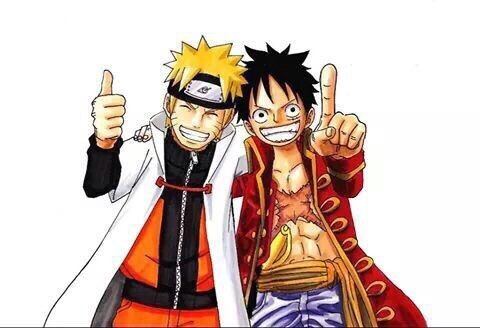
CONCLUSION
From a feminist point of view, Naruto and One Piece have their own shortcomings when it comes to the inclusion and depiction of girls. I particularly chose to talk about them because they are the central faces of the shōnen genre, both of them depict common issues with female representation in most shōnen stories. It is understandable to a certain extent as to why the authors chose to draw/develop their characters, however, the lack of active female characters in shōnen stories fuels the ” shōnen is for boys, therefore, don’t expect female representation” narrative. It would do no harm to write stronger and more complex female characters in these stories, in fact, it would make the stories much more interesting as there is variation in perspectives and experiences— especially now because of the strong societal push toward feminism and the growing female audience consuming anime media. The fact that shounen does target boys is perhaps the most important reason to feature complex, active female characters in these stories—not only as supportive figures or dream girls, but as someone they can relate to and look up to as well.
EXTRA: NEW GENERATION SHŌNEN!
Naruto and One Piece have been in the anime scene for decades, but as societal values shift, many New Generation Shōnen are trying to tackle the inclusion of feminism in their stories. Here are some:
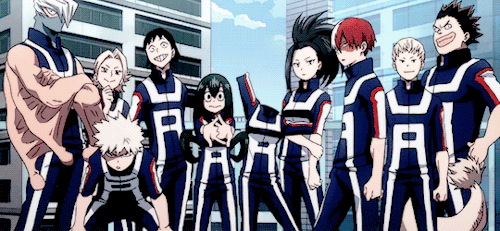
Boku no Hero Academia, one of the primary faces of New Gen Shōnen: A superheroes story where superpowers or quirks rule the world. Physical advantages male characters may have during fights is insignificant as the winner is decided by their ability to use their power at its full potential and their compatibility with the opponent’s quirk. Women are shown to have different body types, breaking the skinny hourglass stereotype with healthy and muscular bodies. Read more on how BNHA is breaking the moulds here: https://www.animefeminist.com/feature-hero-academia-confronts-shonen-sexism/

Mob Psycho 100: A supernatural shōnen where the main character, Mob, struggles with masculinity, battles for self-improvement, and desires to just be an amiable and helpful person. His story breaks the typical toxic masculinity tropes in shonen stories and instead focuses on Mob’s emotional journey to being comfortable with who he is. Read more about this here: https://www.animefeminist.com/anime-feminists-top-25-anime-of-the-decade/

Demon Slayer, another progressive main face of the New Gen Shōnen: A historical supernatural story where women are given major roles and are never looked down upon by their male counterparts. As demon slayers, their attire is unique to each individual yet fit for their job and is not compromised for the sake of fanservice.
- Leanne.
#anime#shonen anime#shonen#feminism#feminist lens#anime analysis#analysis#naruto#naruto shippuden#sakura#one piece#bnha#my hero academia#boku no academia#mob psycho 100#mob psycho#demon slayer#kimetsu no yaiba
28 notes
·
View notes
Text
talkin bout fuckig manga
hey it’s me, haven’t had internet for over a week and i’ve been sick and uni and blah blah blah time for a rant about manga
this time its about "Soredemo Machi wa Mawatteiru", tl;dr, good manga read it idk
lots of bullshit below the cut
Before anything I say gets too confusing or I go off on an insane tangent, just know my recommendation is that you read "Soredemo Machi wa Mawatteiru". It's not very easy to find online since it has an official English release (which my recommendation extends far enough to suggest I might pick up in the future, just to have it, but I am very stingy), but there's an alright torrent of all the volumes on your local anime torrenting website, and is at the very least worth the trouble of reading as such. There is also an anime that gets better as it goes, but the manga is my primary recommendation. Beyond this point I'm not gonna give much regard to what I write, so get ready for anything, read the manga and see if you agree with me, or don't and see if I care:
BOUT THE ANIME: The SoreMachi anime is one of those rare comedy anime you find where the animation and overall production is just really extra the entire time. Hopefully you know what I mean because I won't really be able to explain it any other way, it's simply one of those shows where the jokes are decent and it's a fun time for the most part. Unfortunately, the anime makes a couple of critical missteps that kept me from getting far into it when I first tried watching it about a year ago, and in retrospect seem even less reasonable.
Starting with the good, as an adaptation it does a good job with most chapters it covers, it properly sources where each chapter comes from incase you intend to read the manga and skip around to catch up, and the anime adapts some sections to have additional jokes that fit very naturally in to the story. It also covers up some of those problems only manga can have like having a concert segment without any actual music involved, until they invent mp3-paper it's just something we'll have to live with. Translation work was pretty good (I watched the [WhyNot] release for those who care), which is extra important for something as difficult to translate as jokes from another language. The set of episodes they chose to end on was very good, and was expanded to be a lot more impactful in the anime. If it wasn't for the last episode being as strong as it was I may have given up on finding the manga when I saw it wasn't super easy to read online.
As for what the anime fails in, some episodes feature some really blatant over-acting that doesn't really help make characters believable, and there's this obnoxious gag that continues the whole where through where most scenes have a few seconds long line from what is essentially a forced mascot character, which usually mean nothing and only serve to harm the pacing of many episodes (there isn't even any sort of equivalent bit in the manga so I really don't know why they did it, most of the anime original jokes are pretty good so I just really don't get it). The biggest issue the anime faces is that the source material is about 140 chapters, while the anime is only able to cover 24 chapters. This comes with a LOT of problems, the first being what I'd call the "required reading". SoreMachi is not a 1-note simple comedy where you can skip to any chapter and be completely okay; There are many small but meaningful subplots lying beneath, and characters have a fair bit of development throughout. What this means for the anime is that the first 3-4 episodes are just the first few chapters of the manga, which are a bit rough and not as good as the majority of the work, which is true of a lot of comics (god fuck I promise there will be more than a first chapter of my comic I promise it'll get better fuck). In terms of the anime by itself, I'd say episode 1 is decent, 2 is middling, and by 3/4 their still taking a while to introduce members of the cast, and I didn't immediately want to finish it. I put the show down for a long time until my internet started dying and I wanted to watch something fun. Slapping it back on at episode 5 I immediately had a great time and watched the rest of the show pretty soon after. While I understand the reasoning behind doing this, the anime does not pay off this structure, as beyond the first few episodes, the chapters start being presented out of release order and out of chronological order, kind of destroying any consistent throughline. This decision in and of itself isn't the worst, since the comic isn't always chronological, and the volume ordering is a bit different from the release ordering, but the inconsistency makes the first few episodes feel lessened without reason. The other large failure that comes with only animating about 1/7th of the entire work is that many themes and concepts that are core to the manga are not represented in the anime well at all. One of the biggest is the rare but unnerving supernatural chapters, of which only one is animated, and not a particularly good one. In order to talk about these themes I'll have to transition into talking about the manga itself, since they aren't part of the anime.
DA MANGA: So one last recommendation that you read the manga, the whole damn thing. Cus we're gettin into themes and character moments that take a long time to pay off, and obviously is all part of my interpretations, so if that stuff means anything to you don't let me ruin it for ya.
The title of the manga is, in essence, the entire manga's "punchline" in that every chapter could meaningfully end with simply the text "And yet the town still turns..." (My translation of the title, fuck "And yet, the town revolves" or "But the town moves"); by this I mean most chapters end in an anti-climax where a mystery is left unsolved, or a mystery is solved and undercut by the realization that life simply keeps on going without much change. This is used to essentially force your eyes open to all possibilities when reading, as the main character spends her time acting like a detective, and these mysteries end up as either misunderstandings, secrets, riddles, and sometimes something out of the ordinary happens that makes you unable to pin anything down firmly. Similarly, these endings aren't always read-and-forget scenarios. Several chapters come back in the form of a continued joke, a continued mystery, or contribute to some greater purpose later. Readers are properly rewarded for keeping everything they can in mind, while also tormenting such people with loose ends.
I enjoy Hotori as a protagonist due to her character being defined not in flaws and strengths, but in mindedness. Hotori seems like a simple "haha she's dumb" character to start, but consistently throughout she proves that her strengths are in memory, observation, and deduction, while lacking in some more common sense and abilities. Her brain works in strange ways that some people may or may not understand, such as her need to think through even the most trivial fictional scenarios, which I relate to deeply.
The art and paneling throughout are wonderful. Ishiguro Masakazu is one of those artists who draws very simple characters, but knows how to use details and depth to breath so much life into the artwork. He also clearly uses the occasional supernatural happenings as an excuse to draw what he loved, as all sorts of artistic depictions of the supernatural come out that simply look satisfying. These parts obviously meant a lot to him since he's been working on a primarily mystery-action manga that has a lot more of that stuff in it. (Also, as hindsight is 20/20, if you've read any of his new work you'll notice that the main character of it is eerily similar to a character who shows up very late in SoreMachi that the author obviously fell in love with, cus she just keeps coming back and even ends up with a really unsettling end to her character arc despite only being introduced as a component in a harmless mystery. Feel free to call me out for the same shit 30 years from now when I'll probably do the same shit)
I'd like to get into some of the major themes of this work, as a lot of them hit very close to my mind (which I guess is true of any theme you recognize for yourself, you wouldn't really "get it" if it didn't mean something to you...).
The simplest theme, again, comes from the title. The main character, Hotori, expresses a desire that the town she lives in continues going on, unchanged forever. This is obviously a fear of change, which ya know, same, but also an exploration of what it means to fear change. Hotori actively tries to keep businesses from closing down, keep friends from leaving, and keep relationships from changing, while simultaneously making all sorts of new relationships and solving mysteries. Hotori even comes to realize that simply learning the truth about something changes the world through your own perspective, and that such changes can't be undone. In spite of this, Hotori mostly gets her wish, any time she fears that a large change will impact the town, its resolved about the same as any other issue. Whether its a message that even time can't keep you from your loved ones and that change isn't worth fearing, or a concession that large changes to the setting would be a bad idea in terms of humor, I can't really decide. This theme reaches it's conclusion in what is one in a series of "ending" kinda chapters at the end of the series. Hotori is faced with a supernatural ethical situation, save her town from destruction at the cost of her existence, or live through the disaster, knowing her town and the people in it will forever be changed. While the actual result is that nobody disappears and nothing is lost, and the event may have simply been a strange dream, Hotori confidently decides that sparing the people in her town from a life altering event is worth giving up her memories with them. A kind of bold spit-in-the-face to the idea that change is okay, where we find that Hotori didn't fear change for herself, but rather for the people around her.
There's another major idea in this manga, which takes a very long time to pay off, and completes its arc at the very very very actual end of the series, the idea of "leading someone to be something". A character that rides that line between main and side character, Shizuka, is a writer of detective novels, who feels the best person to judge her works would be a version of herself without the bias of being the author. She tries to achieve this by leading Hotori to be interested in detective works (including her own) and generally be just like her, starting from a young age. The end result is a young girl dead set on being a detective herself (or at least another novelist), while Shizuka keeps her identity as an author secret. She then uses Hotori as a scapegoat for herself, attempting to see how she would solve various mysteries and use that as inspiration, and this is depicted as though Shizuka were some sort of villain, which she may feel like she is. The end result of it all, though, is that Hotori was likely already a detective-minded person, and that even if Shizuka pushed her down that path, it was Hotori's decision to continue down it, and the very end of the manga is a scene revealing that Hotori figured out Shizuka's secret at some point, and even still respected Shizuka and aspired to reach her, and the two accept each other for who they are. I enjoy this ending a lot, since as an artist I've worried that some of my love or aspirations for and from other artists came with an ulterior motive of wanting a better community for art to exist in, but people are people and will make their own decisions, and some day everyone may be able to become equals in a truly meaningful sense, where everyone is inspired by and guiding each other together.
So that probably didn't mean shit to nobody and I didn't even really talk about anything in the comic like most of the main characters or any of the shit goin on but ya know fuck you go read it, and thanks for reading this.
#long ass post#also gonna have finals on my birthday this week so awesome#im having a good time this year h-haha
23 notes
·
View notes
Text
I said it the other day. Let's talk villains. I've seen a phrase going around for a while that says, "Good villains make good heroes." I try to say that good antagonists make good protagonists because that gives you some more room to expand your characters beyond a black and white narrative and put some depth into your story. However, that doesn't mean that the antagonist isn't going to be a villain, so let's go with that original "Good villains make good heroes" and ask, what makes a good villain? To me, there's two main kinds of villains. There's the cartoon villain, you could also say the one-dimensional villain, and then there's a realistic villain, or multi-dimensional villain. For a villain to really be good, you need to be invested in their story even if that investment is hoping for their downfall and to do that, you need to have some kind of depth to be able to latch onto.
Now the first one isn't necessarily from a cartoon but that's the most obvious example. It's a Snidely Whiplash or a Captain Planet villain, a character who twirls their mustache, swirls their cape, cackles at the heroes, and only really has one thing about them. Now this isn't to say you can't have a bad villain in this category but it's harder to make a character like this truly interesting because there is no depth to them. It's like being menaced by a cardboard cutout. Can you care about them being defeated? Yes. Can the hero still be interesting? Yes, but I'd say they need some other tension in the story to make them so because it's not really going to come from the villain. In the end, I'd say you're not going to remember these villains very much because they're not interesting. There's no real investment. You probably can't even get involved heavily rooting for their downfall because it's kind of a forgone conclusion they'll fall in this kind of story. None of this is a bad thing of course, we need stories of all kinds, but let us leave these characters shopping for a new black cape with just the right twirl and talk about the next kind.
Aleksandr Solzhenitsyn wrote The Gulag Archipelago, a book about the Soviet Gulag system. Now, this book is about so much more than what I'm about to pluck out of it for my example here and I can't recommend it enough but in it he says, "To do evil a human being must first of all believe that what he's doing is good, or else that it's a well-considered act in conformity with natural law."
With this we can see what I consider a base for writing a good villain (and how to understand real people doing evil things). In other words, as has been said before, no one is ever the villain of their own story. As you construct your story, as you create your villain, ask questions you would for your other characters. What motivates this person? Why are they doing what they're doing? How do they cope with what they're doing? Who are they? Where has their path come from that brings them to this point? How do they react to things? Are they loud and bombastic or are they quiet and polite? Every villain is a person and you need to make them a person or you're back to cardboard cutout land.
Since this is a She-Ra blog, let's look at one of the villains from the show, Hordak. When he's first introduced, it looks like he's going to be that cartoon villain. He's this lurking dark presence that Shadow Weaver uses as a threat and who only seems to care about conquering the world. The first few times you see him, he's all growls and menace. Then the show starts to flesh him out. You find out he's got Imp and that he obviously cares for him. He interacts with people and you begin to realize that he's not just out to conquer the world just because, he's doing it to show that he's worth something to someone who he holds in high regard. He's got goals and reasons he's doing what he's doing and in doing this the show sets him up for his eventual character arc so you CARE when he's holding Prime over a pit and says, "I am Hordak AND I DEFY YOUR WILL!"
I'd say though, that if they'd decided he was going to be a villain all the way through, you'd still be invested in him. What if the show had him become attached to Entrapta but decided he was going to be evil through and through? That when he gets back to Horde Prime, he turns his back on Entrapta because now he's in the light of his god. If Horde Prime had decided, hey, he's done pretty well for what he thought was a flaw and had given Hordak a position of power. We're of course assuming a slightly different writing of Prime but just go with it. Now imagine the scene with Entrapta, Hordak, and Prime where you've still had the same lead up of Hordak questioning and you're thinking, "Is he going to do it?" Then he actually shoots Entrapta. You'd HATE him but you'd only have got there because you were INVESTED in him because he's a built up, multi-dimensional character.
Now let’s look at Horde Prime. Ah, Prime, I hate you but you're closer to that one-dimensional cartoon villain but you still work. Why? We don't know a huge backstory on him, we don't know what set him down the road, but he still works because he's that embodiment of the quote from The Gulag Archipelago. He would say he doesn't WANT to do these things but they turned from the light of Him so he had to destroy that planet, chip those people, or destroy the universe. He doesn't want to throw Catra off a cliff but, "Some vessels are only destined for destruction."
You can just hear the disappointment in his voice. Oh, how awful... whelp, off the cliff you go. Then when he confronts Adora he has that smarmy, I didn't want to do this but you and she made me do it, voice as he tells her how it didn't have to be like that. And that's how you use a one-dimensional villain to good effect. You lean into that evil, you make them completely confident of what they're doing, you have them saying to themself, "This is good or it's just in line with how the world is" and in doing so, you give at least that one dimension some kind of depth, like a line drawing of a cube.
Anyway, that's just my loose thoughts on this. I feel like I could go deeper on it, like why do we find villains compelling and why do we even identify with them sometimes, but that's a whole other things that'd take much longer.
6 notes
·
View notes
Text
absolutely 0 of my friends want me to write an essay about how paimon is just a worse version of vyrn, so i'm going to do it here
the essay is under the cut if you want to read it
1. intro
First and foremost, who is Paimon? And by extension, who is Vyrn? How are they similar, and why would I want to compare them?
Paimon is from the game Genshin Impact, a popular RPG game that has been going around in the eastern gaming community. It's quite fun to play, but I got bored of it fast, but that is off topic. Paimon is a character that is introduced to you at the very beginning of the game. She's a in-game tutorial character, and also shows up in the game's pause menu. Even outside the pause menu, you see her a LOT in the game. The main quest has her talking quite a lot, and in character side-quests she acts as the main character's companion.
Moving on, Vyrn is apart of my favorite game right now: Granblue Fantasy. If you don't know what Granblue Fantasy is, it's a mobile game that came out in 2014 and is still quite popular today. It is a more visual novel based with an focus on teambuilding over combat. Back to Vyrn, he's also introduced to you at the very beginning of the game, and also acts as the in-game tutorial (somewhat, there are other characters who also guide you through the beginning of the game, but he is the one the player starts off with). Similar to Paimon, Vyrn is with the main character wherever they go, and although not apart of the pause menu, he has dialogue in many, if not the majority, of quests.
Both act as the mascot of each game, which makes each a better sell. They are both cute characters that are supposed to draw people in, which is why they're introduced within the first few seconds of each game. However, they're similarities go beyond that. Although their dialogue is not too similar for me to say that they have the same personality, they most certainly are both strange beings that float/fly, and go with you EVERYWHERE.
Why am I comparing them? The purpose of the essay is to see why I love Vyrn, but hate Paimon. You see, when I started playing Genshin Impact, I have already put months of my time into Granblue Fantasy at that point, so when I saw Paimon in Genshin, I said to myself, "Oh, this girl is cute. She reminds me of Vyrn! How fun!" Now, after putting hours into Genshin Impact, I've found myself to just despise her dialogue. First impressions are everything, but Paimon became more of a thorn in my side as I played through the game. Therefore, I'm here to analyze why.
2. Vyrn and Paimon's relationship to the player
Vyrn and Paimon's relationship to player is extremely interesting to me, and could be the reason why I don't like Paimon as much as I do Vyrn.
Paimon is introduced to the player immediately in the game, which is not a bad thing. Generally, every game has a tutorial stage to help the player figure out what to do and how to play, but Paimon is not a typical tutorial character. In many games that I've played, most tutorial characters are mentor types, and Paimon is not that. Paimon also does not know what this world is and is effectively exploring it WITH you -- not guiding you. This is not inherently bad, since the introduction is not what ticked me off about Paimon in the first place, but later on, it might become clear why I find this a sticking point.
Vyrn, in another game, is introduced very differently. He is introduced as "your best friend" which on it's own is quite weird, considering he's a flying lizard, but you're apart of a new world, anything could happen. He's been alive for an amount of time, so he generally knows what is going on. Not exactly a mentor type, but he gives much more clarity of the world the player is in, at least in comparison to Paimon. In the introduction, he gives a very clear picture of what kind of person the main character is and their backstory. Honestly, I came to trust him very quickly, despite him being a weird little monster.
These introductions in comparison seem really similar, which is why my initial reaction to Paimon was "Oh, this is Vyrn but again."
Now, what I find interesting is the beginning of conflict in both of the games.
Vyrn is introduced almost immediately. There is a beginning cutscene of the main character reading a letter from their father, and then the player meets Vyrn, who comments about the main character reading the letter again. This gives a backstory with Vyrn almost immediately. He knows that the main character has the asperation to get to the land of the astrals, and he wants to help to get main character there. It is only after this scene does conflict start: the Este airship covering the sun.
Paimon does not have this backstory. The initial cutscene in Genshin Impact is vague, to say the least. However, it immediately tells the player the conflict: the main character is searching for their twin. Paimon is not apart of the conflict whatsoever. Making her an outside entity, the main character does not express their troubles to Paimon as they explore this new world.
This marks a key difference in their introductions. Since Granblue Fantasy started the conflict WITH Vyrn, it caused me to be more attached much more quickly. It was clear through Vyrn's actions that he would stand by the main character's side no matter what happened. However, Paimon does not have that same connection. Since Paimon is not apart of the conflict whatsoever, I found a lot of my friends (who haven't played Granblue Fantasy) distrust her very quickly. Some jumped to the conclusion that she is going to be someone evil at the end of the story, and I don't blame them. So far, the only person the player can trust is the twin.
By making Paimon an outside entity to the conflict, it makes her very quickly a potential danger. However, with Vyrn being apart of the conflict, makes him a trustworthy ally.
3. Dialogue
Since the main characters of both Genshin Impact and Granblue Fantasy are self-inserts, someone needs to be able to talk. In Genshin Impact, Paimon is the stand-in to talk for the player, and in Granblue Fantasy, Vyrn is in a similar position. However, their dialogue itself is very different.
Vyrn and Paimon both create nicknames for people, which is why it's very easy to compare the two of them. Vyrn likes to give all of the crewmates nicknames, and none of them seem to mind it. Paimon also gives nicknames to the people her and the main character meet, but it feels less like a joke and more as an insult, calling her nicknames "ugly" and feeling bad when she finds out the nicknames she gives are to important people.
Vyrn's nicknames are generally playful like "Lop Ear" and "Sir Burnsalot," but can get insulting like "Miss Batter-For-Brains" and "Clefty." However, none of the people with the nicknames seems to mind it, despite him saying it very loudly and to their face.
However, Paimon keeps her nicknames almost to herself, as if she's doing them in secret. "Tone-Deaf Bard" and "Guhua Geek" are two of a few of these nicknames. None of the people recieving the nicknames seem very happy about being called that.
Don't get me wrong, both Paimon and Vyrn are being really rude by giving out nicknames to random people, but it's the reactions from the one's receiving said nicknames that gives clarity of the nicknames' true intentions. With the Granblue Fantasy crew not necessarily minding it and Genshin Impact characters getting angry, it becomes clear why the nicknames are created.
Both Vyrn and Paimon talk a lot of both of their respective games, but how the react to the this new world around them that tips the scales of me disliking Paimon.
Vyrn explores the new islands with you with little to no knowledge of the next island the player will fly to, and his reactions to each island are generally pretty on par with the player's. For example, going to an island that covered in mist, he's generally pretty cautious, expressing it in his dialogue.
However, Paimon keeps commenting on the obvious. Her dialogue is almost annoying because it is so obvious. I defeated a boss and she said something along the lines of, "That's it? Where's the treasure?" when there is clear newly-opened door on the other side of the room. The dialogue during the story is not as bad, but I find myself angry at her whenever she speaks anyway. Her comments don't add to the tone or the gameplay. They just frustrate me.
All of her comments and general rudeness make me really angry. She doesn't fight, and she doesn't seem like the one who would fight with me! She's only there to tag along with you, for some unknown reason! Her vagueness makes her worthless to me as the player.
4. Conclusion
The fact that Paimon does not seem like the type to go through thick and thin with the main character makes her frustrating to be around. Her introduction decided her fate of the annoying character that everyone continues to call "Emergency Food" rather than her name.
She's just annoying once you get to a certain part of the story because the constant reminder of her being an outsider is at every corner. She has not once mentioned a THING about the main conflict (finding the main character's twin), and even if she goes through the entire story if the player, she seems like she would run away from the final boss, if she herself ISNT the final boss!
Vyrn at least is like "Oh shit! Time to fight!" and generally is concerned about the main character's health and well-being. He's not much help in a fight, but at the very least he'll express that you need to heal. Vyrn is as much in this conflict of finding the asterals as the main character. He's a trustworthy ally, despite being rude sometimes.
In conclusion, despite being very similar, Paimon was sentenced to me hating her since the beginning because of her placement in the game's main conflict. Vyrn's placement in Granblue Fantasy's main conflict made him a much more trustworthy ally as the game continues.
Sorry for the spacing issues. I'm on mobile. Thanks for reading tho.
Play Granblue Fantasy, it's a good semi-visual novel. Plus, the mascot character isn't as annoying as Paimon.
12 notes
·
View notes
Text
Lady and the Tramp at 34
A review by Adam D. Jaspering
Lady and the Tramp begins with a quote by Josh Billings. “In the whole history of the world there is but one thing that money can not buy… to wit — the wag of a dog’s tail.”
The pithy observance frames the movie: dogs are good. It’s a simple premise. It’s a universal premise. It’s a beloved premise. It’s a marketable premise. People will want to pay money to see a movie about cartoon dogs that fall in love.
For such a simple story, Lady and the Tramp had a lengthy production history. Disney employee Joe Grant drew a springer spaniel named “Lady” in 1937. Walt Disney asked Grant to produce a storyboard for potential projects. Grant obliged, but after several false starts, nothing came to fruition. Lady was a character in search of a project.

Grant left Disney Animation Studios in 1949. His abandoned creation remained behind, unused, somewhat forgotten. In 1953, production began on a new movie featuring dogs. Disney Studios scraped together various, unrelated dog-related material in preparation for the film. Lady finally found her purpose.
“Lady” was pulled from the archives; her species changed to a cocker spaniel. “Tramp” was inspired by a 1945 short story called “Happy Dan, The Cynical Dog,“ written by Ward Greene. Disney even drew inspiration from his own life. After once standing up his wife on a date, he gifted her a puppy in a hat box as an apology. Lady is introduced this way in the film’s opening scene.
It’s easy to consider Lady and the Tramp a simple story, and there’s no shame in that. Cinderella, Alice in Wonderland, and Peter Pan were all spectacles in design and delivery. Disney was well within their rights to slow things down. Lady and the Tramp is both conventional and approachable subject matter. It focuses on the world around us, making the ordinary seem every bit as fanciful and majestic as a far-off land.
Lady and the Tramp is set in the 1910s, forty years before the film’s release. While the period is arbitrary to the story, it’s essential to the film’s appeal. Setting the film in the near past gives it a unique feeling of nostalgic charm. It’s familiar, but also slightly foreign. Enough to pique interest, not so much it alienates. It makes adults think of their glory days, and children think of their grandparents’ house.

Choosing the proper era is a delicate tightrope. Too recent, and it seems old-fashioned but unseasoned. Too far back, it seems ancient and unapproachable. The science behind choosing the right era may be nuanced, but the solution was a foregone conclusion. Disney himself chose the 1910s specifically to recreate his own childhood. A fringe benefit of owning your own film studio.
Lady and the Tramp sets the entire movie from a dog’s perspective. Physically, and dynamically. The movie focuses on dogs and their diminutive vantage point. They spend more time with human ankles than with human faces. Dogs are the main characters, but the world is still decidedly human.

Human buildings, human society, human owners, and human dominance. The dogs relate to each other as neighbors, but they still respect and acknowledge their roles as house pets. The dogs have their own understanding of the world around them, and are powerless to affect it.
The first fifteen minutes introduces us to Lady and her day-to-day life. She’s a dog, and as such she has no real responsibilities. She has no goals, no ambitions, no wants, no desires. She eats, she sleeps, she gets head pats from her masters. She has a pair of friends who stop by occasionally to say hello, but beyond that, she’s very dependent on her owners.
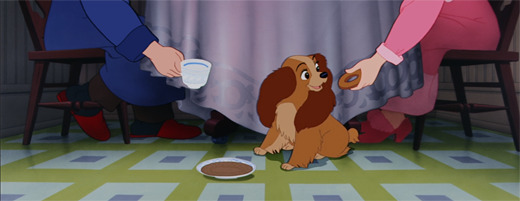
As time moves on, we the viewer learn Lady’s owners are expecting their first child. Lady, having no context for this, is left clueless as to what is happening. All Lady can comprehend is the construction of a nursery, and uncharacteristic exhaustion from the mother-to-be. To the animator’s credit, Lady making inquisitive faces for ten minutes straight never seems forced or repetitive.
It would seem the movie is trying to make a parallel to sibling rivalry, the animosity between children for the attention of their parents. The only difference being, instead of an older and younger child, there’s a dog and a baby. Assuming this was intentional and not subtext, it simply doesn’t work.
Sibling rivalry begins after the birth of a newborn; the eldest child acts out for attention, rebelling against the redefined roles in the family dynamic. They resent they must share attention. This doesn’t happen when one of the participants is not a child, but a household pet. The most beloved of pets mandate less affection than a biological child.

Even Lady, a dog with human attributes, can’t fault her masters for focusing more attention on the baby. Regardless that she is substantially humanized, a dog like Lady is still just a dog. There is an argument that Lady could hypothetically resent the shift attention. She is depicted wanting more facetime and interaction with her owners. She does clearly understand she has lost something.
She could resent the shift, but she doesn’t. Despite being a cartoon, Lady has no autonomy beyond being somebody’s pet. She’s not being neglected, and she’s not being mistreated, so she has no leg to stand on. The baby takes precedent over the dog. Any more than acceptance of the fact would paint Lady as selfish. This film is a romance, and Lady is supposed to be an upright, worthy heroine. She can’t have such a negative trait.
One shouldn’t fret over Lady’s circumstances anyways. The quasi-sibling rivalry concept is abandoned early. Lady doesn’t need to fight, strive, or earn attention from her owners. She doesn’t need to understand how she and the baby each fit into the family. She doesn’t have to revaluate her life of privilege now that elements have been upended. Because Lady’s masters up and leave and won’t return until the film’s conclusion.
What prompts a couple in 1911 to abandon their newborn child for several days is never explained. Is it medical? Is it business? Is it a vacation? Why do both need to leave and why can’t the baby come with them? It’s never addressed or explained. It’s questionable, uncharacteristic, and happens for no reason than to fulfill plot requirements. Lady can’t fall in love with Tramp until Lady flees her home, and Lady won’t flee her home unless Lady’s owners are gone. So Lady’s owners just... leave for some reason.
The nameless infant is left in the charge of Aunt Sarah, an apparent spinster relative to one of the parents. Throughout the Disney catalog, villains are hateful, greedy, angry, and callous. There is no other villain like Aunt Sarah, though. She’s not evil in intent, but so blindingly ignorant to what’s happening around her, the ignorance becomes a form of malice.

Aunt Sarah, embodying a key tenet of old maids, has an affinity for cats. Not only does this mean she has inherent disdain for Lady and all dogs, she brings her two pet cats into a decidedly un-catproofed house. The pair knock over vases, rip up the curtains, and torment a goldfish. Aunt Sarah, in her deliberate ignorance, blames these obvious feline crimes on Lady.
The two Siamese cats are as subtle in design as they are in deed. They are yet another racist caricature that make trawling through the classic Disney films of the 40s and 50s awkward. The animators were flat out deliberate in their disrespect. All they had to do was draw cats. The cats didn’t need to have human attributes at all, especially not Asian characteristics. The animators did not have to give the cats oversized, slanted eyes or buck teeth. They did anyways.
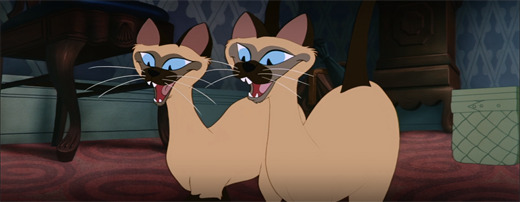
The main offender is their speech. While not a flattering representation of East Asia, it’s also not accurate even in a mocking way. Whatever accent these Siamese cats are speaking in, nobody on planet Earth has ever spoke that way, ever. It’s not Chinese, it’s not Japanese, it’s not Thai, it’s not anything. It’s just generically foreign. The ignorant stereotypical voice is so detached, it forgets what it’s trying to misrepresent. The cats are somehow too racist to actually be racist.
Lady goes through quite a lot in the first half of the film, but where is Tramp? As his name suggests, Tramp is a vagrant mutt (mostly schnauzer). He lives in a railyard and subsists on the handouts of kind restauranteurs. Like Lady, he also has no goals, no dreams and no ambitions. The two were destined to find each other.
Tramp’s life on the street is a stark contrast with Lady’s life of comfortable privilege. Based on this disparity, it’s easy to assume Lady and the Tramp is a film about class differences. When Lady first meets Tramp, Tramp halfheartedly alludes to the restrictions and illusions of security in the upper class, but he mostly shares this opinion to mock Lady’s discomfort. It’s not further explored.
Lady is not an upper class citizen. She doesn’t live in a society at all. She’s a pet. Her owners are affluent, but Lady’s world ends with the fence. She has no idea how the other half lives because the other half never made themselves known to her. It’s difficult to have a story of class consciousness when one character has only met five people in their entire life.
Again, another false start for the movie. Lady and the Tramp isn’t a movie about sibling rivalry, or classism, or the protection of a home from intruding racist cats. The movie sets up different plot threads, and all are a means to nothing. The film is about Lady and Tramp: two cartoon dogs falling in love. It’s what we were sold on. Why does the film try so hard to avoid delivery?
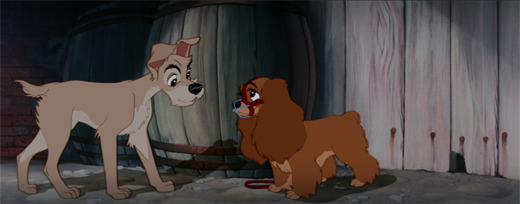
After being muzzled by Aunt Sarah, Lady flees, bumping into Tramp in her panic. Here, finally, Lady and the Tramp begins in earnest. Tramp suggests looking for ideas at the zoo. It’s an impractical solution, perhaps appropriate for a dog’s dexterity and resources. A dog can’t exactly walk into a hardware store and buy wire snips.
The zoo scene is filled with pleasant gags. Incidents with alligators, hyenas, and an extended scene with a beaver are delightful. What became a trip designed for practicality slowly blossoms into a date. The animosity and distaste that previously defined their relationship has disappeared. Finally, our promise of romance has been fulfilled.
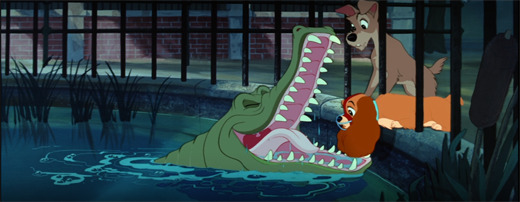
The issue is, now the movie is half over. A normal romance story would have the two leads courting before the first act ends. Lady and the Tramp has been meandering, wasting time, establishing too much scenery that’s going underused. If there were payoffs to all these loose threads at the film’s climax, that would be one thing. But very little receives any sort of callback.
Lady and the Tramp is a movie of fluff and filler, and all of it is in service of one scene. The one scene that rescues Lady and the Tramp from obscurity and irrelevance. The scene that immortalizes its place in film history. The scene where Lady and Tramp share a plate of spaghetti.

Lady and Tramp share a plate of spaghetti while being serenaded by an Italian love song. They’re enamored by the music and the candlelit setting. They take up the two ends of the same spaghetti strand, moving closer to each other in the middle. When they finally meet, they have their first kiss. Inadvertent, but welcome all the same. Anyone waiting patiently has had their romantic thirst sufficiently satisfied.
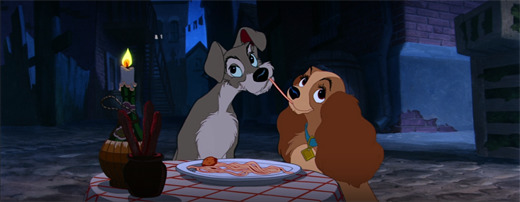
The spaghetti scene has entered the cultural pantheon of romantic moments. It’s been alluded to, referenced, and parodied countless times. It’s more famous than the movie itself. It took a long time to get to, but Disney Studios didn’t blow the opportunity.
There is a distinct lack of purpose and urgency in the film. For long stretches of time, nothing of significance happens. The dogs walk around, the dogs see things, the dogs go places, the dogs talk. Sometimes its to the story’s benefit. Sometimes its to fill silence. Sometimes its to justify the detours. The movie is about two dogs falling in love. It’s paced so poorly, Lady goes on her first date with Tramp, then is ready to break up with him in less than twenty minutes.
This is the issue with Lady and the Tramp. As it turns out, the premise is not whether you would enjoy a movie about two cartoon dogs falling in love. Some viewers would readily accept, while others would require something more substantial. That’s not the premise. The premise is, if you were fully willing to watch a movie about two cartoon dogs falling in love, how much are you willing to endure before it happens?

The conflict, of what little there is, is the standard boilerplate romantic miscommunication. The type of problem that could easily be solved if one party could vocally explain the circumstances, were they were not obstructed by separation or one party’s stubborn refusal to listen. In the case of Lady and the Tramp, Lady is picked up by a dogcatcher and interred in a dog pound. She has her tags, so she’s only being detained for several hours. It’s just long enough to meet one of Tramp’s jilted exes, who regales Lady with a song about how much of a womanizer Tramp is. Or whatever the equivalent of “womanizer” is for dogs.
Regardless of the plot development, this jazzy song and dance number is occurring inside a dog pound. A pound that is very blatantly a stand-in for prison. The inhabitants are incredibly woeful and resigned. Some are actively trying to escape. Some have accepted their fate, singing melancholy dirges about their situation. One dog is literally executed off-camera. This is an incredibly downbeat, sullen, depressing environment. Doubly so that it occurs in what was until now a very uplifting and idyllic picture.

Prior to Lady’s apprehension, Lady and Tramp had a brief but heavy discussion about their future. Sure, they love each other. The night was wonderful, and they’d love more. But Tramp enjoys his freedom. Lady enjoys being a pet. Tramp quickly changes the subject before either is forced to face the consequences. All of this is now compounded.
We arrive at the climax; Lady is scorned by Tramp’s playboy disposition. Tramp is trying to re-evaluate his life ad hoc before the girl he loves escapes him forever, but can’t. Lady tells him off from her doghouse. Concurrently, a rat sneaks into the nursery, terrorizing the baby. Just an ordinary rat. He’s not giant, he’s not rabid, he’s not frenzied. He has evil-looking red eyes, but he’s just a rat.
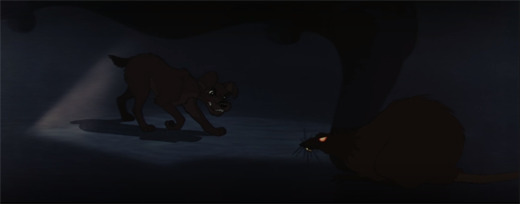
Despite the argument, Tramp helps Lady and saves the baby. Aunt Sarah, useless babysitter that she is, witnesses none of this. She comes in too late, finding the screaming infant and the stray dog. Aunt Sarah calls the dogcatcher, who immediately apprehends Tramp. Lady realizes how much Tramp was willing to sacrifice for her. Tramp really had changed, and Lady really did love him. With a series of well-placed barks, Lady is able to communicate to her human owners the exact situation.
We’ll ignore how Lady’s owners return from their contrived absence at the exact moment Tramp is being carted off. We’ll ignore how Lady’s owners understand precisely what is happening from a series of barks. We’ll ignore the humans’ staked interest in Tramp despite never seeing Tramp before, ever. We’ll also ignore how much more invested the parents are in the dogcatcher fiasco than their baby being attacked moments ago.
Tramp sacrificed everything to assist Lady. And in a turnabout, Lady sacrifices nothing. The dogcatcher’s truck is stopped by one of Lady’s friends, a geriatric coonhound named Trusty. Trusty almost dies in the process (suffering only a broken leg thanks to Disney magic). Lady’s owners adopt Tramp, taking on the extra burden of another pet. Tramp forfeits his rambling vagabond lifestyle. Lady has given up nothing at all. It’s not that she doesn’t deserve a happy ending, but couldn’t she at least muss up her coat?

Lady has four puppies in the film’s epilogue. Her owners previously had trouble dividing attention between a baby and one dog. Now they have a baby and six dogs. The dogcatcher is a very prolific figure in Lady and the Tramp. He’s clearly overworked due to the town’s overpopulation problem. One would think both Lady and Tramp would be fixed promptly.
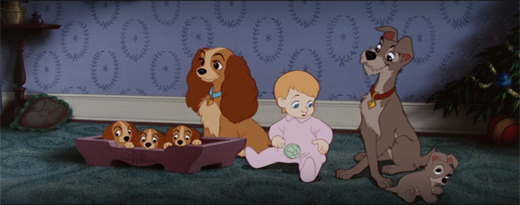
Lady and the Tramp is a movie that is self-conscious about its simple premise. It tries to mask its inferiority complex by dressing it up in weightier ideas and concepts. Very few of these additions are explored to any sort of fruition. As such, the most core romance is denied proper focus.
The romantic element is unfulfilling except for a few scenes, which entirely save the film. There’s nothing inherently wrong with Lady and the Tramp (excusing a few questionable cats), but there’s also little good to say in its favor. Unless you really, really like seeing cartoon dogs fall in love.
Fantasia Snow White and the Seven Dwarfs Cinderella Alice in Wonderland Pinocchio Bambi The Three Caballeros Lady and the Tramp Peter Pan Dumbo Melody Time Saludos Amigos The Adventures of Ichabod and Mr. Toad Fun and Fancy Free Make Mine Music
#Disney#walt disney#Walt Disney Animation Studios#disney studios#Lady and the Tramp#1955#Film Criticism#film analysis#movie review#Disney Canon
9 notes
·
View notes
Note
i did not realize tippi/bleck was your OTP please tell me more about why you love them (i also like them but its been years since i played spm so i need to renew that love)
(It’s been years for me too and I’ve been meaning to replay I will just never tire of them.)
So I’m actually going to break this ask down into two parts. The first just talking about their relationship in general and what the game presents, the second actually getting into how they are the ship that very much defined what I consider a lot of my personal ship tropes today. This also isn’t the first time I’ve gone off about them either so I’m going to link this post from 2013. (It’s not my best analysis and I don’t necessarily agree with everything in it now but I mean I was 17 so for a seventeen year old who had no critical thinking skills, I think it was good for what I wanted to convey at the time. XD)
So with that out of the way let’s talk about those memories.
"I remember that day well... The room was warm. The whole place was at peace."
This is the introducing line to the first memory, to the story of Blumiere and Timpani that serves as the foundation for the story of the game, and it shows how much this day meant to Blumiere that even lost in the shadow that became Count Bleck, fallen into darkness and depression and utter self loathing, that he remembered this day as a positive despite it being, as he himself says, “the day that our tragedy was set in motion.” The memories are fond to him and his small bits of happiness, and the idea of that is heartwarming to say the least. It also gives a very early establishment on why their interactions are significant. A lot of the lore is read between the lines, but the game establishes quickly that humans and the Tribe of Darkness do not like each other. So when Timpani shows that she doesn’t care what he is, just that he needed help, it very quickly establishes both her character and why we should empathize with this unknown, and it establishes her bond with Blumiere.
She saved him without knowing who he was. Her kindness and empathy is what draws Blumiere in. And it proves a very strong foundation for their relationship as it progresses. From here in story, we’re only given snippets of who they were before. They give further background on the prejudices against them, how Blumiere’s father is working to keep them apart, and how they seem willing to overcome the obstacles at every turn. Despite the warning from the first memory, you cheer for these unknowns and hope for their happiness, it’s what they deserve. The memories where they’re happy (Blumiere proposing to Timpani, the one with them under the stars, even them just getting to talk again) are wholesome and heartwarming. And the one where Timpani tries to leave after Chapter 3 is heartbreaking. Because you want to believe in their happy ending.
Which of course gets taken away in the Chapter 6 interlude. Watching Blumiere learn that Timpani is gone, well...I’ll grab the dialogue exchange here:
"Timpani! What did you do with her? I must see her!" "Still your tongue, Blumiere... Can't you see you've been duped by a dirty human? You have brought shame to my name...and to the entire Tribe of Darkness!" "And so what if I did? That doesn't matter to me! She's my entire world!" "Well, then it will interest you to know...that she no longer resides in this world." "What... What do you mean by that?!" "This is the price those who resist their own fate must pay, my son." "She... No... It can't be so!" "Someday you will see, Son. Our kind and humans must never mix."
Yeah, it’s pretty depressing honestly. Blumiere is so clearly heartbroken and destroyed to the point that it basically convinces him that nothing matters. That he’s willing to destroy his home and everything else in the entire universe because he has nothing. This is a broken man, and it’s why he finally heeds the Prognosticus’s call in the final interlude before the main fight to become Count Bleck.
Now granted it’s not a sucker punch to see the interlude unless you haven’t been picking up the hints in the Castle Bleck scene (Chapter 6 does a fantastic job of hammering in who Blumiere is) watching Blumiere in desperation turn to the book right before you lead into Chapter 8 really hammers home how little he had to live for.
And this is double if you take a lot of the popular fan headcanons (his mother being dead, often times at the hands of humans. His father being abusive. That kind of stuff) as fact for Blumiere’s story. This was quite possibly one of the only people to ever show him kindness, and he lost her, for as far as he’s concerned, forever, and it destroys him.
Which takes us to the timeline of the main game which does an equally good job of fleshing out their love. While the game first points Count Bleck out as an absolute madman and threat with a desire to do nothing more than destroy and recreate the world however he wants, he doesn’t stay that way. The game first foreshadows that something happened to push him over the edge early on and his interactions with Nastasia where he even lets her back out show that he’s fully aware of his actions and not some delusional monster, but chapter 6 in this exchange really drives everything home.
Count Bleck: You QUESTION Count Bleck?! This worthless world's destruction matters not! Far better for Count Bleck to wipe it out of existence than let it remain! Tippi: How can you say that? That's...horrible! Count Bleck: Count Bleck scoffs at you! An insignificant Pixl lectures Count Bleck on what is right and wrong? Tippi: This is not up for discussion! You're wrong...and sick! All living things have a heart. They're all priceless. You can't just...erase them! Count Bleck: Of all things, you defend the heart? Nothing could be more worthless...All things...are meaningless. Aside from Timpani, no treasure mattered in the least to me...
First since this happens before the memory I put earlier this is your first sign that something awful happened to Timpani, but it also just really drives home just how the loss of Timpani drove the hopelessly in love Blumiere into depression and sent him spiraling. All you know is that Blumiere lost Timpani, and he might as well be dead for what’s left of him, and it’s heartbreaking.
But then Tippi remembers, and Count Bleck realizes exactly who she is. Blumiere learns his quest for destruction of the worlds that took her away from him and of himself is meaningless, and Timpani learns that the madman she’s hated, wanted desperately to stop, is the one person who means the world to her. And the result when they reunite is absolutely devastating as Blumiere attempts to play the part the prophecy sets out for him, and Timpani just wants her husband to stop. Blumiere is throwing the battle because now that he knows she’s alive, he can’t hurt her. He doesn’t want to win. He wants to die, and he wants the world to be safe for her, because all he wants is her happiness and her ability to live. The final boss sequence is absolutely killer if you have any investment in their relationship for that reason at all because they’re so in love and both know what they want can’t happen. And it’s heartbreaking.
Then Dimentio happens and in a desperate attempt to save the world, they confess they love each other and use the power of the Pure Hearts and their love for each other to destroy the Chaos Heart. The lines like actually made me emotional now and I’m reading them out of context in a script and not after the about ten hour journey of the main game.
Count Bleck: There were so many things I wanted to say to you...but I could not find the words. Tippi: Oh, Blumiere... Only one thing matters to me now. I never had the chance to return your question... Blumiere... Do you still love me, as well? Count Bleck: Of course... I have thought about you every moment since you disappeared... But I have caused you so much suffering... Tippi: Perhaps...my life would have been more carefree without you, that is true. Count Bleck: But I had to be with you, Timpani. I will never apologize for that... Tippi: I know, Blumiere. And I love you... Count Bleck: And I love you, Timpani... Hundreds of thousands of years from now, that fact will not have changed...
Like look I’m not here to provide an emotional analysis I don’t have to this is just very good. “And I love you, Timpani... Hundreds of thousands of years from now, that fact will not have changed...” is just honestly a beautiful line and I honestly cry just reading it now. (I’m not joking I have fangirl grin on my face just from reading this I miss these two so much.)
And to get their final dialogue, much like the memory scenes from earlier in the game, the conclusion to their tale immediately after this:
"Timpani...do you remember the promise we made to each other that day?" "Yes, I remember..." "If there was a place where we could be happy together, we would find it." "Will you come with me to that place now?" "Blumiere... Of course... I will always be with you..."
It’s just very sweet and satisfying after going through the story. You’ve spent so long rooting for them to have their chance (since the moment you understood what was going on in the memories) that it makes the conclusion all the more just wholesome and satisfying that after everything they’ve been to, they finally get to be together and happy, as shown by the scene in the after credits where they walk down the hill together.
So to tie all this part together, the brilliant writing of SPM is really what gives this ship the chance to shine. By giving us time to get attached to Count Bleck and Tippi first before revealing who they are, we already have a baseline investment in their happiness and thus in the ship. The ship comes secondary to their characters so you have these two already very enjoyable characters (Tippi’s sarcasm and interactions with the heroes of light are a a lot fun, and Count Bleck is so charismatic that whenever he and his minions are on screen they dominate) and then you add in ship that makes an enjoyable build up to the game with good chemistry and mostly heartwarming moments, and make it a tragedy, and it becomes very easy to get invested in it, and to love. And it makes for one of my personal favorite love stories I’ve seen in gaming.
The rest of this essay is more to do with my personal taste and less objectivity so I’m going to throw it under a read more but oh boy did this ship either literally shape my ship tropes or just hit almost every single one of them I have that well.
So needless to say I have loved this ship since I first beat the game probably about thirteen years ago so it’s hard to say whether my ship taste came first or this game defined my ship taste but let me just list all my tropes and you’ll see what I mean:
Light/Dark Dichotomy - From looks to roles, these two embody this trope to a tee. Timpani is light, she’s a descendant of the Tribe of Ancients, the guardians of the Light Prognosticus, and in game is represented in the rainbow butterfly form, who while angular her colors and overall form (butterflies) tend to give her this general association of friend. She fights for the heroes and radiates a presence of general light. Blumiere is her opposite, a member of the Tribe of Darkness, the guardians of the Dark Prognosticus, and in game is represented by mostly darker colors. He is the main antagonist and his presence in game is often tied to some of its darker moments. They embody this contrast.
Opposing Sides - I need to preface the way I’ve phrased this. In most instances I would call this “Enemies to Lovers” however because of the storyline of this game it’s not quite enemies to lovers but it sure does embody the spirit of the trope where two people are fighting against each other despite loving each other and spend the majority of the game not in love with each other because Blumiere has no idea who she is and Timpani has zero memories. The important thing is that they are working against each other, and the tension of going against somebody you love is wonderful. The scene preceding the Count Bleck boss fight embody everything good about this trope.
Forbidden Love - I mean this is literally obvious but Blumiere’s father is literally against the pairing from minute one and literally tries to kill Timpani over it this pairing is as forbidden as they come.
Tragic - I don’t need to define why Timpani and Blumiere are tragic but boy do I love me some good angst and these two are legitimately swimming in it it’s very very good. My favorite thing about the angst is that it never affects the overall tone which is a testament to how well the game is written. Slight tangent but like SPM as a whole gets very very dark, partially due to the Timpani/Blumiere elements and their tragedy but also in part due to the last three chapters of the game. Like Chapter 6 is definitely the heaviest hitter but there’s a lot to unpack in Chapters 7 and 8 as well. But despite this the game’s atmosphere never feels oppressing, it’s still fun with lighthearted moments and it’s still a game that won’t make you feel super depressed. It balances its darkness with the bright colors and the tone of the writing very well. And because of that, despite the fact that they literally destroy a world while you’re on it and then send you to the Mario version of hell, the game never feels too dark to be enjoyable.
The rest of these aren’t as clearly defined by words but I am very much a sucker for the idea of “my love for you is my one weakness” and the one thing that could be used to bring somebody down and drag them to hell. But also being the one thing that’s keeping them out of going down and the one thing that can bring them back out. It makes me emotional and I love it. I would also like to propose the idea that Timpani and Blumiere are soulmates since they’re most definitely true loves but things like soulmates are kind of subjective in the first place.
To tie it all home you can see the elements of my long standing SPM obsession littered in my fandom tastes today if you look hard enough for it. This game had a major part in forming my tastes because before Kingdom Hearts, even before Pokemon Mystery Dungeon, this was the game that captured my heart and attention. It’s the only game to have an amount of (sadly unpublished and lost on old devices that no longer work) writing to rival the amount of things I’ve written for KH over the years. And at the heart of the phenomenal game is a wonderful ship that, years after my last playthrough of the game, still holds a spot in my heart reserved for it.
Timpani and Blumiere are a fantastic ship and between its wonderful writing and its effects on my taste, it has a lot of reasons to still be my favorite ship of all time.
#Paper Mario#Super Paper Mario#Tippi#Count Bleck#Timpani#Blumiere#I love these two beyond words#taliaxlatia#Heather Answers#Heather Does Something#Forgot to add my analysis tag to this post
30 notes
·
View notes
Text
Nature vs Nurture
two book reviews

I went from one book to the other fairly quickly and was fascinated by the difference in the stories in how they address lineage. Understandably, there will be small differences due to the setting, however I’m not entirely convinced it plays as big of a part as people might think.
We’ll start with ‘The Daughter of Sherlock Holmes’ by Leonard Goldberg. As you can gather from the title this first story follows the daughter of the famous detective as well as the son of Dr. Watson we’re all so familiar with. The characters are pleasant enough and the hints of romance are cute, however though, there are moments where I had to pause and question why a person would think certain conversations are appropriate for the stage of the mystery or the stage of their relationship. The mystery itself is fascinating; Mr. Goldberg has managed to weave together a narrative that parallels the original mysteries of Sherlock Holmes. While I was excited every time another classic case was referenced, it was also the main problem with the story. I recognized the original cases and would immediately remember suspects and culprits in the original rather than focus on the actions and introductions of current characters in the story I was supposed to be reading.
In ‘A Study in Charlotte’ by Brittany Cavallaro we have a case where we are looking at the great-great-great grandchildren of Mr. Holmes and Dr. Watson. The story delights in dropping hints that the Holmes and Watson clan’s remain tight knit, with Jamie Watson’s mother even expressing how often “a Holmes pulls a Watson into trouble with them”. The characters once again are recreations of their namesakes with the character of Charlotte emulating her ancestor, however, while Jaime Watson, who takes after the original John Watson, makes an attempt to differentiate himself from. The mystery again centers on classic Sherlock Holmes tales, with the culprit recreating scenes and deaths from the original stories.
To compare.
Sherlock Holmes:
The legendary detective is not in these stories, but his bloodline is. Comparatively both Joanna (Daughter of Sherlock Holmes) and Charlotte (A Study in Charlotte) are bright women. Joanna seems to come to her knowledge through interest in articles and an excellent memory. While it’s something that Charlotte was trained to have since her birth due to familial legacy. Between the two Charlotte is a more human character as she experiences genuine hardships and reacts to them appropriately while Joanna seems almost untouchable. If you prefer your Holmes to be more aloof then Joanna is your Holmes. However my personal preference leans towards Charlotte as she is written as a flawed human being and thus feels more real in that regard. Which may have something to do with the nature vs nurture that is brought up and/or hinted at in these two books. I’ll get to that in a moment.
The Watsons:
The Watson men act as our narrators for both tales, and while I would like to say I prefer one over the other, however, in taking a step back both these boys lose their minds over a pretty face. Dr. John Watson Sr in ‘Daughter of Sherlock Holmes’ is very considerate towards women, and treats Joanna with respect while John Jr. seems to forget himself at moments. Jamie(A study in Charlotte), however is much more immature in that he feels compelled to act protective for Charlotte’s sake. While John Jr. does not seem to forget that Joanna is a Holmes and seems to be watching to see how close to Sherlock she is, Jamie does not always act like it despite how Jamie idolizes Charlotte due to her family name.
The Mysteries:
Both cases draw their inspiration from the original stories. In ‘Daughter of Sherlock Holmes’ it’s interesting to see many past cases woven into the main story; for anyone familiar with the original source material you’ll find yourself looking for little clues and hints and often finding them. It’s a fun little scavenger hunt but as stated above does require a level of familiarity with the original source material. In ‘A Study in Charlotte’ the story themes become darker, more foreboding. Instead of seeing the fun scavenger hunt from the previous story, readers may instead see the looming threat as the mystery unravels.
Nature vs. Nurture:
“Nature versus Nurture” isn’t a new concept, for those unfamiliar it asks if it is more important to be born with certain inalienable talents influenced by genetics and other biological factors or are a person's choices and talents defined by their collective experiences and exposures? In ‘Daughter of Sherlock Holmes’ they tend to forget ‘Nurture’ as an aspect. The bad guys always beget bad guys while good creates good, never allowing the apple to fall far from the proverbial tree. This leaves little to no breathing room for character growth, as within the world of the story, people will always be exactly what they’ve always been with no room for change. The stories tend to become carbon copies, because if Sherlock Holmes did it this way then so too will his descendants. It’s a shame, because it squanders the opportunity to tell a story, while not wholly original, from a different and unique perspective as no two lives are lived exactly the same. Conversely, ‘A Study in Charlotte’ leaves much more freedom to explore the nurture aspect. While the character of Jamie wants to keep Charlotte atop a pedestal solely based on her family name, she is instead determined to be her own person and not a carbon copy. The familial lines of past Sherlockian characters are given the chance to grow and change, to be their own person instead of trapped in an endless cycle. No one is inherently good, evil, or given a pass based on familial connections.
Conclusion:
It’s hard to present both sides of a topic as complex as Nature vs. Nurture, however the overly simplified take of the concept in ‘Daughter of Sherlock Holmes’ made it hard to continue reading, in fact there were several times where I nearly gave up. They mystery plays out like a standard police procedural, choosing to focus on methods and techniques. How will they find the killer, how will they prove it? The story does a good job of explaining the characters techniques and methods, but leaves very little for the characters themselves. Holmes and Watson may as well be carbon copies of the originals and eschews actual character growth for sly nods to the originals.
In comparison, ‘Charlotte’ plays more like a contemporary thriller. The mystery plays second to the characters but it still leaves enough clues and hints to entice you without worrying about every single detail. You feel more invested in the character’s personal growth as they struggle both with their own personal legacies and the killer.
If you only have time for a single mystery in your life, I personally found ‘A Study in Charlotte’ to be the more satisfying read. Both books are merely the first books in their respective four parts series and worth reading, however while I look forward to continuing the adventure introduced by Brittany Cavallaro, I will not be reading the next book by Leonard Goldberg anytime soon.
#Sherlock Holmes#Book Review#not gms related#The Daughter of Sherlock Holmes#Leonard Goldberg#A Study in Charlotte#Brittany Cavallaro#edited
19 notes
·
View notes
Text
gary’s writing workshop: lesson 6: point of view, part 2
aka: POVs/Subplots Are My OTP
To discuss the connection between POVs and subplots, first we must revisit the topics of plot structure, flow, continuity, purpose, and readability.
Subplots add complexity and depth to a story.
They give the writer the opportunity to show another aspect of the main character’s personality, how people can wear multiple hats in their lives. Brienne is a fearsome warrior, but she’s also sensitive and gentle. Jaime is a snarkmaster deluxe, but he’s also a huge romantic and secret chivalric hero.
Unless you can find a main plot that somehow showcases all of the above at once – not easy – you need to add a subplot or two in order to provide opportunities to display all the facets of their personalities, not just the ones that are used in the main plot. If you don’t, you run the risk of a story that feels monotonous and characters that feel flat.
Likewise, when a story gains the complexity of subplots, it can start to feel unrealistic, too busy, or even claustrophobic when everything is from a single character’s POV. She’s everywhere at once, has a finger in every pie and no time off. My recommendation is that no main character should be the POV of more than two plots. If your story has more than two plots, it might be best to have the third one related by another character, to permit some fresh air into the narrative.
In the Plot Structuring lesson, we discussed how scenes need to have a purpose: they must connect the prior scenes to the next, and push the plot forward in a substantive way. They need to make sense within the timeline, in forming one in a series of steps from the story’s start to its finish. Similarly, scenes need to make sense regarding whose POV they are placed in.
Who Should Get a POV?
Choosing who gets a POV in a story is a very big and important decision, because they are the character(s) who the story will be filtered through. Their thoughts and feelings and motivations will be visible to us in ways they will not be to the other characters.
The strength of narration tends to become weakened with each character added, because the reader becomes used to one person’s headspace, and then you’re shoving them into someone else. And many writers get so invested in the ratio of POV trade-off1 that the plot’s needs are ignored in order to follow this pattern. Instead of carrying through with the momentum created from the prior chapter, “It’s a Jaime chapter!” they exclaim, and so they switch to him even though they really should be sticking with Brienne, etc.
In other words, there should be a point to why we’re in another person all of a sudden, and that point should not be “It’s easier to describe this scene from the other characters’s POV”. POVs should belong to characters who are either primary in the main plot, or primary in their own subplot. In a romance, that would probably be two people: both halves of the romantic couple. In non-romantic plots or sub-plots, whoever are primary2 characters in them might have the POV.
If you do choose to have multiple POVs in a story, it shouldn’t just be for a single scene or chapter – POVs should not be squandered, as they’re more integral to the flow and continuity of a story than many people think. Shoehorning in a new POV for only one chapter can be a Chekhov’s Gun; if there’s no future to the person having their own POV, if there won’t be follow-through later on, it weakens the story. The reader is left wondering why we’ve been granted access to the new POV character’s head, only to never visit it again.
Exceptions: Sometimes at the beginning or end of a story, an alternate POV can serve as a quasi-omniscient POV, serving to provide information that the main characters have no access to but with a more personal touch, thanks to the character’s limited POV. I’ve done this twice, and looking back, I’m not sure I’d do it again, because in hindsight it feels like one of them is a Chekhov’s Gun and the other is a Deux Ex Machina.
Questions to ask yourself when deciding whether or not to add another POV to a story:
What inner voice/narrative/introspection is so important for the reader to witness that it justifies adding another POV to the story?
What inner voice/narrative/introspection is so important for the reader to witness that it justifies adding another POV to the story?
Will the story lose something if you don’t have access to the other character’s POV?
Is suspense an integral part of your story? If so, this is an especially important decision, because including other POVs can kill the mystery you need to maintain. OR will the suspense be enhanced because switching to another POV means that the cliffhanger you left the previous chapter on will be permitted to ripen?
If the conclusion you draw to these is that yes, adding another POV to the story will be a good idea, then go for it.
Headhopping
Headhopping is frequent switching of POV from one character to the next. How you define ‘frequent’ is subjective; IMO, more than twice a chapter is too much. Unless there’s a damned good reason for it – i.e. there are multiple strong and important subplots that take place in different locations3 – it’s best to limit the number of narrating characters to the minimum required to write a good story, without dumping in superfluous POV just ‘cuz.
Otherwise, you run the risk of the story feeling chaotic and disorganized to the reader: who’s the main character? Who are we supposed to identify with? Oh, we’re back to the first guy now? Who’s next? If your reader is questioning what’s going on, you’ve killed your readability4.
Having many characters as focal points can prevent the reader from making a connection with them, with the result that they become acquainted but don’t really get to know and identify with any, and thus they don’t become too emotionally invested, losing the compulsion to keep reading. Worse, they might take a disliking to a character and skip chapters featuring him/her5.
Pantser alert: I find that people who don’t plan out their plots, and whose POV each chapter will be written in, ahead of time end up being headhoppers. They’re just writing the story as it occurs to them, one chapter at a time, and when they hit a snag, or can’t figure out how to describe something they want to show, they hit on switching POVs as the solution instead of restructuring.
This tends to result in not only a weaker narrative but also weak characterization in the new additions, since little to no thought was put into it and there’s little actual function the new POV provides besides fixing the corner the author wrote themselves into.
If you want to reveal an event occurring without the main character(s) being present, instead of introducing yet another character6, maybe try to restructure the plot instead; can it be captured on video that the character can see later? Featured on the news/in the paper? Recounted by another character who was there? If the character is perceptive/deductive/good at drawing conclusions, perhaps include hints and signs of what occurred and have them figure it out on their own?
Bottom line: Including more than two characters without compromising the flow of the narrative and without becoming chaotic is possible, of course. It’s just not as easy as many people think it is and often can lead to a weak story. Be critical and selective when you choose to add another POV to your story, and see if there are alternatives, first.
How Many Is Too Many?
There’s no law stating how many – or how few – POVs you are allowed to have. However, a general rule of thumb is that the shorter the story, the fewer subplots (and thus, the fewer POVs) your story should have. More POVs = more complexity, and shorter stories just don’t have the length needed to do each of them justice. You need time to develop a character’s inner voice, and it’s just not possible7 with fewer than ~5,000 words per POV.
Here’s a rough idea of how long various types of stories are, and a recommended maximum number of POVs in each.
Drabble: 250 – 1,000 words. One POV, one plot.
Short story: 1,000 – 10,000. One POV, one plot.
Novelette: 10,000 – 30,000. Up to two POVs, max of two plots if done carefully, otherwise one plot.
Novella: 30,000 – 60,000. One or two POVs, at least two plots.
Novel: 60,000 – 80,000. At least two POVs, at least two plots and max of three plots.
Super Novel: 80,000 – 100,000. At least two POVs, at least two plots and max of four plots.
Epic: 100,000+. At least two POVs, at least three plots.
Switching POVs
Making your way, as a writer, from one character’s POV to another can be done in two ways: a hard, clear break, such as beginning a new chapter or inserting a scene break; and a gradual, smooth transition in the middle of the narrative.
I used to use the latter, and you can see it frequently in my Bleach fic, Become A Ghost. I have come to feel that it weakens the narrative because when you a read a scene, you become accustomed and settle into the mindset of one character… and then sliiiiiide into another’s, and it causes a moment of realization that you’re now in the head of someone else.
It’s not hugely objectionable, but I think it does compromise the readability of the story, and thus I’ve come to eliminate it. My stories now only feature hard POV switches, or don’t switch at all, remaining in a single character’s POV the entire time.
Deep POV
Deep POV is a narrative technique that works to eliminate the distance between the reader and the POV character. There is no headhopping, no visible narrator, and as few marks of authorship as possible. Its purpose is to coax the reader to submerge themselves in the character’s perspective and ‘become one’ with the character as much as possible.
Marks of authorship are things like filter words, dialogue tags8, and any wording that would be unnatural to a character’s narrative. To write with Deep POV, you have to commit to limiting the character’s knowledge to only what they’d personally be aware of.
The first Jaime POV scene in Desperado is a decent example of Deep POV because it’s very introspective and mostly avoids these characteristics. Some still exist, however, so I’ve revised instances of them to be more in line with a deep POV.
Depending on word choice, it can be as purple9 as you want… or not. Just tone it down, if you have concerns about things becoming too overwrought.
Footnotes
1 1:1, 2:2, etc. i.e. a chapter featuring one main character, then a chapter with the other main character, then the first again, back and forth, etc.
2 This doesn’t mean “anyone who has any involvement whatsoever in the sub-plot”, just those to whom it pertains critically.
3 For example, in the A Song of Ice and Fire series of books, Jon’s at the Wall, Sansa’s in King’s Landing, Daenerys is in Essos, Brienne and Jaime are fucking about in the Riverlands, Sandor and Arya are fucking about in the Vale, Bran is prancing about the North, Tyrion is all over the damned place, etc.
4 Readability being defined, as mentioned in prior lessons, as how effortlessly a reader can become immersed in a story and move without interruption through it. Readability means there are the fewest number possible of things that can snag the reader’s attention, confuse them, or otherwise drag them back out of the story to the real world. Our goal as writers is to infuse our work with as much effortless readability as possible.
5 As someone who has been told many times that readers are skipping chapters in one story because they feature characters or pairings they don’t like, it’s really fucking annoying. You work so hard to create a complex story, build people and relationships, and weave the plot and subplots through it all in a way that’s at least marginally coherent, and you get “LOL I just haaaaate this character, I don’t read those chapters!” and “Gawd, these other characters bore me, I skip those! Tee hee!”. Well, fuck you very much.
6 Especially if you’ll only be using them for a single scene in the middle of the story: that’s a Chekhov’s Gun situation where the character his/herself is the gun, and not an item or situation.
7 At least, it’s not possible to do well with fewer than ~5,000 words per POV.
8 We will go over both filter words and dialogue tags in more detail in later lessons.
9 Prose can be called “purple” when it’s so overblown, ornate, or fancy that it distracts the reader and draws attention to itself, and not in a good way.
© 2019 to me
43 notes
·
View notes
Text
Supergirl and Queerbaiting
Kara Danvers and Lena Luthor are endgame. At least, that’s what the majority of fans of these two believe. Supporters of Kara and Lena, aka Supercorp, have been arguing for them to get together since season 2, but the writers seem to insist that they are just friends, even as they continue to write scenes that mirror other popular tv show couples. This results in queerbaiting.
Queerbaiting, a media tactic that hints at a queer relationship to attract LGBT viewers, has become a rising issue in the past 10 years, with shows like Supernatural, Sherlock, Teen Wolf, Once Upon a Time, The 100, and Rizzoli & Isles contributing to the problem [x]. Afierra from Hypable wrote an article on the issue of queerbaiting within Supergirl, illustrating how the queerbaiting on Supergirl is so strong that even non-LGBT fans can pick up on it.
I want to illustrate how queerbaiting negatively impacts the LGBT fan community. Based on a majority of fan comments found on Tumblr, many fans are ecstatic about the idea of Kara and Lena’s relationship developing into a romantic one [x]. The reason so many fans are fairly positive about the progression of Supercorp’s relationship is that a show previously accused of queerbaiting, The Legend of Korra, revealed in the series finale that the two characters that were used for the “queerbaiting” actually ended up together [x]. This gives many fans of Kara and Lena hope that the two will get together romantically someday on the show.
Comparing Lena and Kara’s relationship to other canon couples from other TV shows demonstrates how the show writers of Supergirl have continued to ‘string along’ the LGBT fans, resulting in fans being extremely displeased and let down. Additionally, with mental health issues being a higher risk for LGBT youth, it is important to look at the negative effects of queerbaiting as it may exacerbate the already alarming state of mental health of LGBT fans.
Evidence of Queerbaiting within Supergirl
Since the introduction of Lena Luthor at the beginning of season 2, “fans of their “relationship” began to emerge, mostly due to the natural chemistry between the two actresses” [x]. There are countless gifs of the flirtatious nature of their relationship. Another gif illustrates how Kara made the same face when James Olsen spoke, whom she was interested in romantically, as when Lena Luthor spoke to her, resulting in hope that Lena will become a love interest for Kara [x].
However, Supergirl is now on its fifth season, and there is no evidence - besides the hope from fans - that Kara and Lena will get together romantically. However, there is speculation that Supercorp will happen as within the Arrowverse shows the main characters have their one and only since the first few seasons of the show - Oliver met Felicity in season one, Iris has been on the show since day one, and Sara met Ava in the third season of Legends and their relationship is still going strong. Besides Lena, her sister, and her father figure, there is no other character that has been on the show for very long; in fact, most of the cast for the fifth season was introduced last season. Additionally, Kara and Lena are portrayed in typical superhero tropes that parallel other shows like Arrow, The Flash, Legends of Tomorrow, and even from past shows that depict Superman and Lois Lane [x].
The biggest parallels that fans of Supercorp make is with Superman and Lois Lane, like Kara hovering outside Lena’s window [x]. Another parallel was drawn between Supergirl and The Legend of Korra, where both Kara and Korra are incredibly powerful beings who have an intense love of food, and Asami and Lena are both brilliant women who have an engineering background and have strayed from their families’ beliefs [x]. Asami and Lena have done whatever they could to protect Korra/Kara, and have both inherited their families’ companies, becoming the CEO [x]. Not to mention that both Korra and Asami dated the same man, Mako, at different points during the show, while Kara and Lena both dated the same man, James, at different points during the show. This gives fans of Supercorp hope that Kara and Lena’s relationship will develop into a romantic one, as Supergirl and The Legend of Korra are both very similar shows and Korra and Asami from Legend of Korra ended up together in the end.
All of this - the parallels between other couples from other shows as well as romantically inclined scenes between Kara and Lena - have given fans a base for their belief that the show writers of Supergirl are actively queerbaiting, in which they purposely make the scenes between Kara and Lena somewhat romantic in order to draw in an LGBT audience. At this point, the queerbaiting has become so strong “it’s no longer just Kara and Lena fans who are interpreting their interactions as amorous. People who are completely indifferent to the pair or don’t even watch the show are recognizing what’s happening” [x].
For over three years, Supercorp fans have been queerbaited by the show writers of Supergirl, and this constant queerbaiting affects the LGBT fans because there isn’t a belief that “it’s just a matter of time” but that they must hold dear and take whatever scraps they are given. The fans want and hope that Supercorp will happen, but there isn’t any fan that is 100% sure that Kara and Lena will end up together like fans of heterosexual couples. This lack of certainty that LGBT fans exhibit is based on the history of LGBT portrayal within the media. The lack of portrayal of LGBT fans in the past, as well as a history of queerbaiting from a multitude of popular shows, results in LGBT fans’ low confidence in seeing themselves represented on screen.
Research that Supports the Negative Effects of Queerbaiting
LGBT fans have only just begun to see a spark of more LGBT centered shows and movies within the past few years, but there are also many shows which have queerbaited their LGBT audience. For instance, The 100, while giving its audience a lesbian “relationship” between Clarke and Lexa, \they had a total of two romantic scenes in which Lexa was killed off the show right after the last romantic scene of the two. A majority of the fans were outraged due to the Bury Your Gays (BYG) trope, where a character who is revealed to have a queer identity is then shortly killed off the show because the “BYG trope punishes these characters by erasing them from the narrative entirely if the depiction indeed goes beyond subtext to include acknowledged queer identity” [x]. Both queerbaiting and the BYG trope is harmful to the LGBT fan community as fans see themselves in these characters, and when those characters are pushed into an opposite-sex relationship or their sexuality is limited to subtext, it implies to the LGBT fan community that their sexuality should never be acted on and they should always remain hidden. More than 70% of LGBT youth have reported “feeling sad or helpless for at least two weeks in the past year” [x], and with popular media utilizing queerbaiting within their shows, it doesn’t help the already despondent LGBT youth. Therefore, “both queerbaiting and BYG… punish queer audiences by the suggestion (or even promise) of quality LGBTQ representation, only to have their hopes dashed” [x].
In season five of Supergirl, the queerbaiting has reached a whole new level in that the fans don’t even need to reach to find hidden implications of a romantic nature between Kara and Lena. But throughout these Supercorp scenes, there are always reaffirming their friendship status. By the writers reaffirming Kara and Lena’s relationship as “just friends” and then at the same time playing into the romantic tropes between Kara and Lena, it gives the LGBT fan less confidence to believe that they will get to see the happily ever after they crave because, in the past, many relationships they believed had the potential to be something more was written off as “just friends” or the characters that were confirmed queer were then killed off. This implies to the LGBT fan community that having a happy ending isn’t for queer characters and therefore, not for their queer audience either.
The LGBT youth fan community is already struggling with mental illness and a sense of identity due to having to hide their true selves or be unable to acknowledge it because of still prevalent homophobia, so many will turn to media as a distraction or even as a way to gain hope for their own future. But when so many shows are debased to queerbaiting, the hope these fans have for their future becomes further diminished with lack of representation, and will negatively affect the LGBT fan audience to believe that nothing will come out of their hopes and beliefs of two characters getting together romantically.
Conclusion
From the analysis of the evidence above, it’s becoming more obvious that the Supergirl writers are actively queerbaiting their audience to the point that LGBT fans aren’t the only ones noticing it. As discussed previously, queerbaiting negatively affects LGBT youth as it diminishes their hope for a better future, further outcasts them within society, and lowers their self-confidence. Therefore, with a popular show that is so clearly queerbaiting its audience, it further drives the previous negative points of this issue because it's now seen by all types of audience members that the LGBT fans aren’t worth the happy ending they seek within popular media.
Producers and writers of popular media need to understand the detrimental effects of queerbaiting the LGBT fan community. Therefore, more action will be taken by fans if they feel that Supergirl has wronged them in the lack of representation between Kara and Lena.
Therefore, the writers of Supergirl need to either stop blatantly queerbaiting their audience or allow for Kara and Lena’s relationship to develop into what many fans have already vied for: Supercorp. If the writers continue to walk the path they’re currently on, fans will become outraged and the ratings of their show will come down. So, for the benefit of Supergirl, the fans’ happiness and mental stability, stop with Supercorp and queerbaiting.
#supergirl#queerbaiting#supergirl and queerbaiting#kara danvers#kara zor el#lena luthor#supercorp#supercorp text post#supercorptextpost#supergirl text post#supergirltextpost#lgbt#lgbt fans#lgbt fans deserve better#lgbt audience#queerbaiting is bad#please stop queerbaiting#the 100#clarke griffin#commander lexa#lexa#legend of korra#korrasami#korra#asami#clexa#mental illness#mental health#byg trope#byg
6 notes
·
View notes
Text
Caato Higashikata, the case of a character getting overhyped
aka. Caato Higashikata, the most overhyped part 8 character or Caato and Jobin, the perfect mother & son duo.
Warning: This contains JoJolion (part 8) spoilers, if you are a fan of JJBA but haven’t caught up yet, I suggest to ignore this post (and/or save it from later). This was written when chapter 92 is the latest chapter in JoJolion. I’m not responsible for future errors and contradictions in this post caused by the retcon from the chapters onwards.
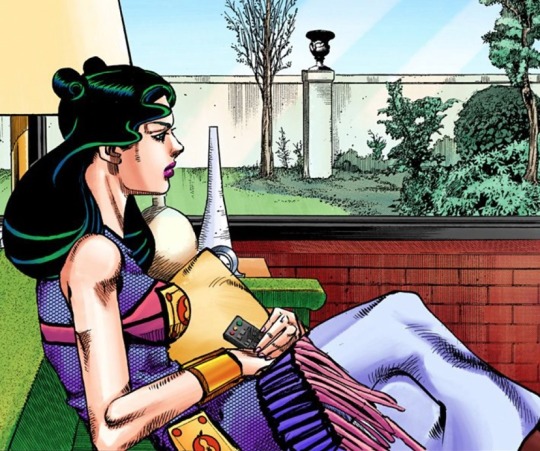
Yeah, currently she is one of the potential main villains nominated by the fans, besides Jobin and The Head Doctor.
However, lately Caato hasn't made any new appearance, but the hype from her fans is still raging. She is pretty cool character but sometimes her hype is getting annoying lately. It’s similar case with Suiryuu from One-Punch Man back during the Super Fight arc, when his fans were hyping him to be one of Saitama’s greatest threat, even as strong as Boros. Now, what is left is only the meme (“Suiryuu’s leg band is his limiter LOL”) and I don’t want Caato to be left as a meme.
This post is not about bashing Caato, it explains the problem in overhyping her. It contains about my thought about her, how I view her current role, the character study and how we should take her character at this moment.
Read carefully because if you’re speed-reading, you likely miss my points and accuse that I’m bashing her.
Contents:
What do you think about Caato?
Why don't you think that she will be the main villain?
What are the common reasons for Caato’s fans who want her to be the main villain and what are your thoughts?
What does Caato really need to be a proper main villain?
How about the other main villain candidates, Head Doctor and Jobin?
So how do you see Caato’s role currently?
How shall we consider Caato’s role right now?
<TL;DR is available at the end of the post>
What do you think about Caato?
Like what I said before, she is pretty cool character. Her first appearance is pretty iconic, when she was just released from prison and she coolly called her son. The way she threw away her wedding ring, symbolizes that she has left the past behind.
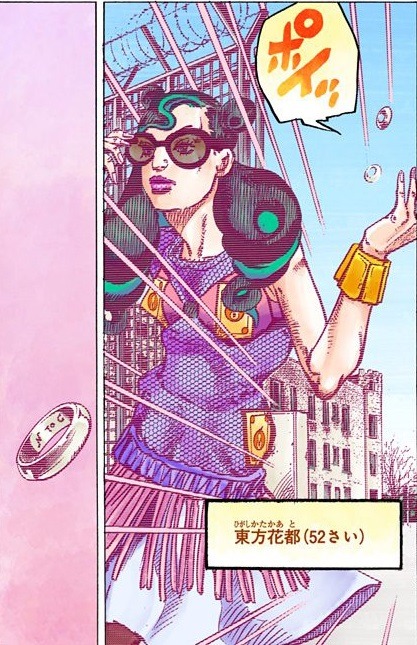
Then when she casually slipped into the Higashikata house, shocking her children and especially her ex-husband, owning Joshu for humiliating her. It’s pretty fun, reminds me of Joseph and Lisa Lisa’s interaction before he realized that she is his mother.
Then came the flashback, about her and Jobin. Her desire to save her son but on the other hand she also had the desire to live a long life. Resulted in her success in saving Jobin and staying alive by sacrificing the lives of stranger’s son, but at the expense of going to prison and becoming a criminal. Thus, sacrificing 15 years of her life, away from her family and freedom. And instead of lamenting, she casually returned to her normal life without considering her ex-husband’s objection while still supporting her son by providing information.
Her design is quite unique and attractive, though I don’t consider her being that hot and enchanting (not on Lisa Lisa and Lucy’s level). Her style and the way she dresses tends to be more eccentric (like any other Higashikatas).

Yeah, I ended up liking her character. She is normal as a character in JoJo standard but very fun as a mom character in every anime/manga. She is already a fine character, her portrayal is solid. She is already perfect as she is. Therefore, she does not have to be the main villain.
Why don't you think that she will be the main villain?
I have written my reasons before, why I won't like it if she becomes the Main Villain. To be honest, I don’t think her character concept and designation role are suitable for a main villain.
Introduction
First, her cool introduction. I like how Araki drew the angle and prespective in the day of Caato’s release scene. Her face that partially hidden then the angle trick that only reveal a little hint of how she looks. This surely gives us the vibe of major character, that she would be important in the future. Who is she and what is her role? Not only that, he also drew her fairly attractive in contrast to those ugly extras. The chapter also implied that there is something dangerous will be brought by this character.
Then does this mean that she is main villain? Nope. Araki’s introduction of how the main villain (and other major characters) appears is pretty unpredictable. Remember Lucy Steel? Her first appearance is “she was just there” besides Stephen Steel with no dialogue, her design (and face) also looked pretty generic (with that Steely Dan’s hairstyle). I didn’t expect her to be important, she was just a random girl happened to be Stephen’s eye candy (like Yuuya’s girlfriends). But then, fast forward later, she becomes the best girl in Steel Ball Run with prominent roles. Once she becomes important, Araki also draws her later as the hottest JoJo chick since Lisa Lisa.
Then, there is Sandman. We started the Steel Ball Run chapter with him. We saw his POV, he was greatly misunderstood by his fellow Indians from reading the white men’s books. If you are not familiar with JJBA and just happened to read this chapter as your first introduction to the series, you likely would misunderstand Sandman as the main protagonist. As we all know, the main protagonist must belong to the Joestar’s bloodline.
Then what about Caato and her cool intro? I can guarantee that she is important as a character. That’s all. I think between Caato and Lucy’s introductions, it’s only a matter of when Araki decides the role for his characters.
Conclusion: Caato might be a character with important role, full stop.
Character Background
What is Caato’s background? She is introduced as the mother of four Higashikata children, ex-wife of Higashikata Norisuke IV, the current patriarch of the family and the head of its family business (The Fruit Company). An ex-convict as her interesting background. Kinda weak character background for a main villain imo, but this does not automatically debunk her to be the main villain. Some JoJo main villains have very flashy backgrounds, we got non-human entity like The Pillar Men and that flashy vampire, mafia boss, the priest and U.S president. But we also got a mere salary man who wants a quiet life. Jobin himself is just an heir to his family (and business).
However, let’s compare their respective settings, especially in part 4. Kira Yoshikage is just a salary man with his hand fetish who wants a quiet life. Let’s focus on his salary man part first. While Kira only held such ordinary occupation as a main villain, the setting of part 4 in JoJo doesn't have anyone else in more glorious positions. Okay wrong, there are grandpa Joseph as a real estate tycoon and Jotaro as marine biologist. But what do their careers have to do with the plot and main goal in part 4? Nothing. Those career are not required to chase a serial murderer, it requires Stand users.
What about part 8? At least there are currently two people who hold more prominent occupations than the Higashikata mother and son duo. They are The Head Doctor and Holy Joestar-Kira. There was also Damo as the head of the smuggling cartel in the Locacaca Organization but he was already ruled out from the main villain candidate. Is there any correlation between their occupations and the main theme in part 8? Of course, because the main focus in this part is The Locacaca fruit. Both Head Doctor and Holy have conducted research on the fruit as scientists. Just like Caato and Jobin, all of them need (and are fighting over) that fruit. But Head Doctor and Holy were few steps closer in utilizing the fruit for greater purpose. Not only that, the Head Doctor is also the presumed mastermind of the Locacaca Organization and its members are extremely knowledgeable in the nature of the Locacaca.
Besides come from the rich family who can buy that worth hundreds of billions fruit, the lack of prominent position held by Caato and Jobin weakens their potential as the main villain, but that doesn't mean I eliminate them as candidates.
On the other hand, if I really want a female to be the main villain, surely I would prefer Holy over Caato. Sadly but fortunately (and just as I thought), chapter 92 seems to have debunked Holy as the potential villain.
Conclusion: Caato’s character background got challenged.
Objective and Motivation
What is Caato’s objectives likely? What I know so far are: she wanted to save her son’s life, freeing him from the Rock Disease. But it had been solved in the past. After she got released from prison, she wants the Higashikata’s fortune, to take back what she thinks her right. She holds revenge on her ex-husband due to him abandoned her. Her other possibly objective is helping Jobin to get the New Locacaca fruit to save her grandson, maybe… but so far she is still MIA.
Okay, let’s compare her objective with the other main villain’s candidates. What about The Head Doctor? What exactly is his goal? His goal is not very clear yet, but being the presumed mastermind of the Locacaca organization makes me feel that he has grand plan. We can guess that among of them is to gain the power of the New Locacaca's equivalent exchange along with the refinement of Locacaca fruit for medical applications. Also, his current objective is to secure the New Locacaca for its medicinal properties along with the benefit of at the very least the members of his organization and possibly the Rock Human race at large (implied by Urban Guerrilla).
With this, Caato’s motive becomes very personal and ordinarily plain but also more humane and relatable to us whereas the Head Doctor’s motive sounds more grandiose and idealistic. Though personally, I’m more interested in the Head Doctor’s objective because it sounds more interesting to be challenged by our protagonists. Besides that, I'm also not interested in the Higashikata family drama that Caato will bring likely. To get the family’s fortune and take over its business (by controlling her son ala queen mother?). Why would I bother to read a seinen battle manga with a conflict like this if I could just watch some TV dramas with similar plot? Not that I completely reject this plot, but for me this kind of conflict should not be the main focus (and goal) in this story.
Then, what about Jobin’s objective? He finally got the grafted branch and betrayed the Locacaca group. His priority right now is to save Tsurugi and cure him of the rock disease. He is also motivated to improve his family's business with innovation (with this, he often at odds with his father).
Caato might shares similar goal with Jobin, but for me her motivation to achieve one of her goals (in saving Tsurugi) sounds rather weak. I'm not saying that she doesn't care, of course she cares about her family. But I do not feel that her will to save her grandchild would be as strong as her will to save her son years ago. Because for me the family bond between mother and child is definitely stronger than grandmother and her grandchild.
Unless when she has lost all her children and her grandchild is the only offspring left for her (coughErinacough). Of course at this time Caato does not experience that, all of her children are still well and there. Moreover, we haven't seen her interaction with her grandchild yet, how could she develop a strong bond with him? But for Jobin, he was feeling a great urge to save Tsurugi, a feeling similar to what Caato has felt in “Mother & Child” flashback.
So, Caato’s motivation in fulfilling the objective to save her family is more likely for the sake of Jobin than for Tsurugi. Chances are, she will help Jobin due to her empathy. She might just do anything for her son Jobin, including saving her grandchild Tsurugi. But that is because it started from Jobin who really wanted to save his son. Because her motivation is not based on her own will, but from her son’s urge, this motivation is not suitable for a main villain but perfect for a supportive character (either for villain or protagonist).
But what about Pucci? Isn't his motivation and objective largely due to DIO’s influence? Yeah, that’s true. But in my opinion it is also because Pucci and DIO are already match-made-in-heaven (beginning with their friendship). I mean, they are perfect as friends. Before Pucci met DIO, he was already the person who would do anything he can to accomplish his goals, even kill and manipulate others, because he really believes it is for a greater good for everyone. After DIO influenced his belief, Pucci aspires to implement a plan long formulated by DIO to "achieve heaven" to obtain the true happiness. So, from the beginning they have the same goal and when Pucci can fulfill it (with DIO’s help posthumously), why not?
Even if you are not satisfied by this explanation, let’s say that Pucci and Caato's motivations are equally weak, the role of the main villain still favors Pucci more since DIO is posthumous character in part 6 (which is already dead and only appeared in flashbacks), unlike Caato and Jobin which are both still alive and exist in the storyline. Pucci’s objective also sounds grandiose and idealistic just like The Head Doctor. This is fit for the main villain. He achieved heaven by speeding up the time until the universe reset itself. Then the souls of the living would be transferred over to the 'new' universe. Everyone in the new universe gained a sort of clairvoyance, predicting the events just before they happen, something which Pucci believes is true happiness. Pucci’s desire is to make sure everyone knows about their destiny and have them accept it. Demanding alimony and divorce settlements or saving her family member is relatively small goal compared to attaining heaven.
If so, how about part 4 Kira? He doesn’t have any motivation besides wanting a quiet life with his girlfriend. Again, the theme in part 4 and part 8 is completely different. The main objective of part 4 is to pursue a serial murderer who cleverly manages to hide his identity and crime. That serial murderer is Kira Yoshikage, he is the main target in the story. Prior to become a target, he was casually committing his crime. Only when he realized that people began to hunt for him, he developed his new motivation to protect himself. Then, what is the main focus in part 8? It’s about breaking the curse and the Locacaca fruit. The target is not an individual, but rather an object. If so, how will we get the main villain? Either we get none or it will be someone in a high position and has a very big influence, someone that is closest to take the advantage of that fruit, the biggest mastermind or… character that we’re already very familiar with, Jobin. So, comparing part 4 and part 8 wouldn’t work (besides they took in the same setting).
Conclusion: Caato either needs motivation that will affect many characters or a high ground. It doesn't have to be grandiose, but her motivation must be independent from anyone especially Jobin.
What are the common reasons for Caato’s fans who want her to be the main villain and what are your thoughts?
”Her Stand had space-themed ability, just like D4C.”
Caato's Stand appears to take the form of a simple deck of playing cards. However, by placing an object between two cards of the deck, she can store that object in the deck itself as if nothing was there. She can store objects that are considerably larger than the deck, as seen when she brings forth a chair. Currently, its name is still unknown. “Placing an object between two cards” part kinda reminds of D4C in application. Many people also consider Caato's Stand to be space-themed like D4C. Considering that the main villains’ Stands were time-based on the original verse, many fans assume that the main villain’s Stand in the rebooted SBR verse will be space-themed. Thus, the hype of Caato's Stand and conspiracy theory of Kaato as part 8 main villain began.

Not only that, Caato also successfully surprised her family when she managed to sneak into his residence suddenly. How can it possible? Did she use her Stand? It's possible, but this is not always the case. Instead of Stand ability, it could just be a simple comedy scene. You can’t really judge the character’s power from a comical scene, do you think that Nami is physically stronger than Luffy just because she can punch him occasionally? Seriously. Judging a character’s power would be more accurate if that happens in a tense/menacing moment. This is just another fun dynamic of The Higashikata family, but this time also featured the mom/grandma. Come on, she just wanted to be reunited with her family.
If you still demand in-universe explanation, well... JJBA has a rule that Stand users with the same bloodline are be able to feel each other's presence. Since all members of the Higashikata family are Stand users, they should be able to sense each other's presence. But as Joseph from part 3 had said that they are unable to tell exactly whom and how many they sense.

SC chapter 138: DIO’s World - Part 5
if this rule still applies, it would make sense that those Higashikata did not even realize that someone (who is related by blood) had sneaked in their home and they were not aware that their numbers were increasing.
The D4C-alike theory sounds nice but let's look at the facts we have currently: has it been confirmed that Araki will use space as the new theme for his main villain’s Stand? Or will he try out new creative ways by not sticking to the theme? Time-based Stand started in part 3 and we could only see the pattern after at least two villains onwards have the same type of ability. But what about part 1 and part 2? The main villains did not use Stand at that time didn’t have time-based ability, are we going to ignore this possibility in the future?
What I see so far in Caato's Stand is that it works similar to Enigma but limited to her 52 deck of cards, of course it’s still early to judge that its ability is only limited to that, given that the first time we saw D4C, it wasn't very impressive either. But it’s also too soon in hyping that she will demonstrate OP ability. It’s hard to predict whether we will see further into her Stand again or not, but we need to if we really want her to be the main villain. However, problem is that we are getting closer to the climax and end-game. Is there still enough time to hype Caato? Speaking of further abilities, do you remember when Jobin said that there is hidden ability from Speed King that he had not demonstrated yet? Flash forward, we finally have seen more of Speed King ability in his fight with Ojiro.

In addition, there are also those who say that Caato uses cards as medium for her Stand, her French playing cards are used to symbolize the game and she likely holds the trump card, meaning that she would be the master of the game and likely would be the winner. What is the game? The main plot in part 8: the race of the Locacaca fruit. This also related to her name being named after “Card”. But wait, doesn’t Daiya’s Stand also use a game namely chess as a medium? Even compared to playing cards, chess game is closer to symbolizing strategy and mastermind. Moreover, California King Bed’s ability deals on memory, it's more fitting for mastermind.
Read further: Caato’s Stand and its mechanism so far
”Her eyes look split, she could be rock human, or fusion human like Josuke.”
Due to her strange eyes close up in her first introduction chapter coupled with her youthful look, a quite popular theory emerged that Caato’s having the split eyes like Josuke due to the strange dark shadow in the middle of her iris. Speculation that she is a rock human or fusion human of two individuals like Josuke had sprung up (and it still continues among her fans).
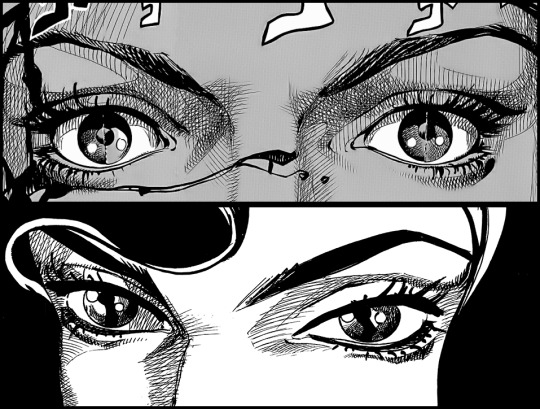
However when the official colored JoJolion chapters got released, the coloring team didn't color Caato’s eyes in two different colors. Why did they decide that?

I had tried to break down it and this is the result:

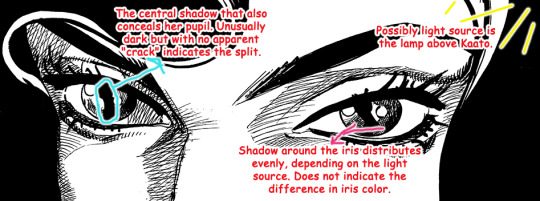
For further explanation, please click here.
”She looks young and the reproduction between human male and rock-human female is possible now, she could be rock human.”
What about her youthful look? Sure, she indeed looks young for a 52 years old gilf compared to Holy who’s also 52. But unlike Lisa Lisa who is indeed considered to be ageless in the story (being a hamon user, Joseph estimated her being around 20s and was shocked when he discovered that she was actually 50), Caato’s sudden appearance in front of her family only surprised them and made them wonder who she is? No comment about her supposedly youthful look, Hato even immediately mentioned her age correctly.

Not only that, her youthful look seemed to have been debunked once Holy made her new appearance in recent chapter and she is no less young looking than her. In the end, this is just a matter of Araki’s new art style. In short, Caato’s youthful looking ended up being irrelevant to the plot.
Read further: Caato Higashikata, is she Lisa Lisa 2.0?
Apart from those matters, chapter 81 also stated that rock humans are able to have sex with humans, but they’re always incompatible (相容れない) with them. It’s still not known whether it means “they can’t reproduce” or “conflict will be inevitable”. But chapter 46 actually said in the pages about Rock Humans that they can’t have children with humans. Unfortunatelly, I could not check whether there is a translation error or not because I can’t find the Japanese raw with the size large enough to be able to read the kanji.
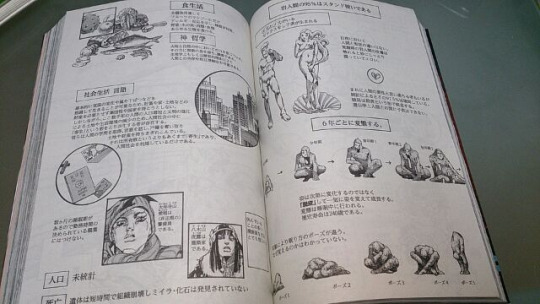
However, recent chapter of JoJolion (99) updated the information regarding the rock-human that only rock-women and humans can have children, but it also showed us how rock-women give birth to their children. If Caato was a rock-human, then that would've meant everyone except Norisuke and Mitsuba were rock-humans, and Tsurugi wouldn't have existed.
Read further: Is Caato a Rock-Woman?
”She got that menacing Aura and she might has hidden agenda, what if she is the mastermind behind all this?”
Based on the theory above, it develops into conspiracy that she becomes the mastermind behind The Locacaca Organization, even she is allegedly the Head Doctor’s superior. I don’t know what basis could have produced this theory other than the assumption that she is a rock human. Could it be due to her menacing aura and being full of mystery? Or how Jobin is being respectful to her? Or maybe is it because her little charm as the officers in the prison like her, because main villain always needs charisma (but Kira and Diavolo). But, of course when you’re leading something, you need charisma (except Diavolo).
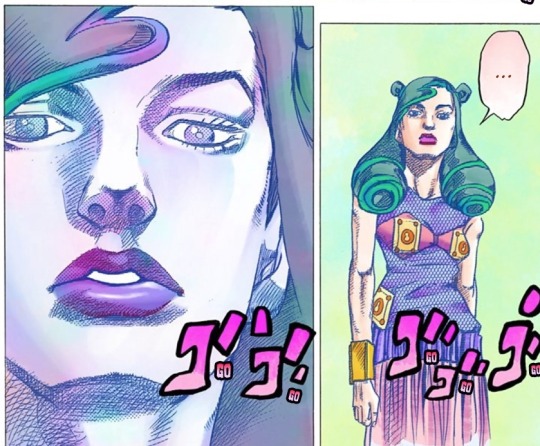
We all know that menacing aura, especially among JoJo females, is not limited to villains or people with very high positions. Remember Lisa Lisa’s cold glare to Joseph during his pillar training?

Or Yukako’s horror aura to Koichi in that window scene which is so iconic till it becomes a meme?

Even though menacing Caato looks the best thanks for Araki’s evolving art style, her simple cold glare and menacing aura do not guarantee her to be the main villain… just not enough yet. Yeah sure, her family were wary of her, but it's more because Hato heard the little info about her mother that she was in prison for a murder that she doesn’t recall the full story, Joshu was wary of this unknown woman and Norisuke IV was surprised to her sudden arrival as she did not notify him first. Nothing about her being ultra dangerous.
What about Jobin’s respect for her? Isn't it nice to have a main villain who is well respected… by one person? Why is being respected by Jobin making her potential main villain? Most likely because after all this time the fans predicted Jobin as the main villain, they saw at him as he is subject to her. I think the train of thought like this is still too hasty. For me what's wrong with a child respecting his mother? Of course Caato deserves his respect, she is a loving mother, wanting to save her son’s life from the rock disease. It might sound selfish since she didn't want to sacrifice her life but it’s also very humane. Perhaps she thought that Jobin shouldn’t lose his mother figure too young. Moreover, Jobin is not the only child she had. What about his younger siblings if they have to live without their mother. Although this very ironic, because despite being alive, she eventually left her children and made them grow up without mother figure. Jobin’s respect to his mother is exactly the same as Joseph’s respect to his grandma Erina.
Then, since Jobin shows his respect to Caato, there is also emerging rumor that Caato is controlling Jobin as the mastermind. Does this mean that all this time Jobin's actions have been under her control? How is that possible? Since Jobin might had been the only child who had ever visited her in prison, do you think she often instructed him to do something at that time? So far, have we really seen Caato give any instructions to him? I do not remember. What I can remember the most is when she called and warned Jobin that:

“There is something fishy between Norisuke IV and Josuke but actually I don't really know what. I was married with him for years so I know his habits. There must be something your father is hiding now, you must be careful!” (JJL ch 59 "Dolomite's Blue Lagoon - part 1")
What I really take in her character based on this scene is that she is very supportive mom, taking her time to help Jobin while she also has her own business with Norisuke IV, not controlling him. This reminds me of Yoshihiro’s role in part 4. She even caught their suspicious behavior from them based on her spending time with Norisuke IV as his wife. This kind of intuition commonly can be felt by any married women, no need to be the mastermind to be able to do it.
Is it possible that Caato is the true mastermind? How does she take care of her organization? If indeed she is secretly managing a secret organization, since when? If it's been a long time and she was very busy with it, why did she married a human who is fruit parlor owner, wasting her life for around 17 years and produced 4 children with him? For what purpose? How does she manage of her organization while hiding this fact from her family?
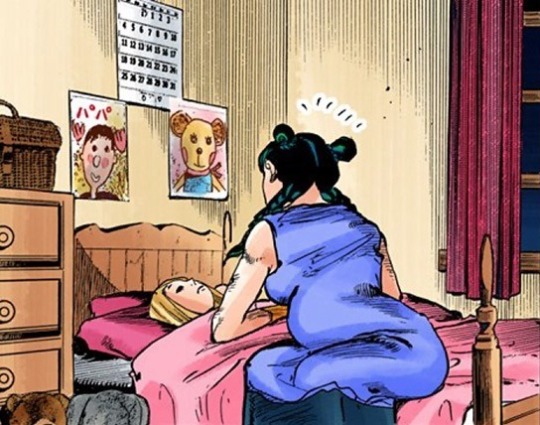
”Surely she was very busy managing the organization.”
If it's been since she was being incarcerated, how was it done? More importantly, does Jobin know? If Caato is indeed leading a secret organization, there's still a lot we need to see: what kind of organization is that? How does Caato run it? What is its main goal? Who are the members? When will they begin to act?
I also hate when they treat Caato as if she is omniscient. One thing that is certain is that she did not know about Mamezuku Rai, the plant appraiser employed by Norisuke IV a year after she was incarcerated (unless Jobin tells her later). Then:
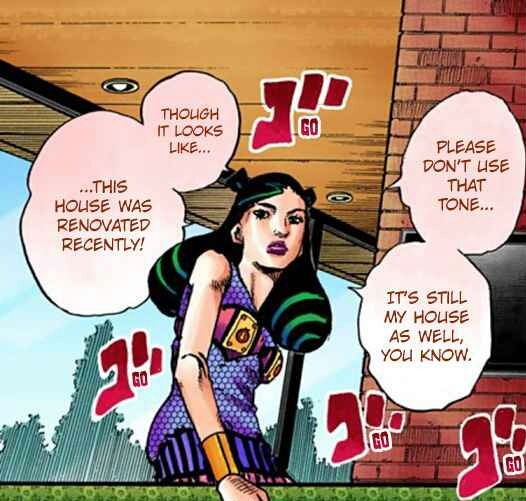
This could have double meaning as well, either she really just learned that the house has been renovated or simply commented about the renovation (I still bet the former). Take a note that the renovation was done 2 years ago (she was still incarcerated atm). But if Caato already knew about renovation (and that shaddy business), how could she not figure out the details of Norisuke IV and Josuke’s secret plans?
As for Locacaca, we still don’t know whether Caato knows about it or not. However, Holy is already ahead of her as Holy even tried to do scientific analysis of it.

Lastly, I also don't think that Caato is really that powerful (as in influence/not Stand) as she was unable to get out of prison earlier (unless you argue that she did it on purpose). Even being a model prisoner didn’t grant her remission. In fact, I become suspicious, is there anyone who intentionally keep her in prison?
”Caato is the true mastermind who led/works with Damokan group as Jobin is just a gofer.”
There is also theory that Caato is the true mastermind from Higashikata family who works with Damokan group in money-laundering and smuggling the Locacaca, instead of Jobin. How so? I bet the theory was born because of this little panel:
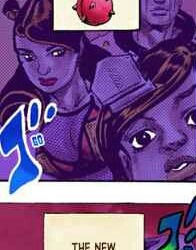
They said the timeline with Jobin does not match, I don’t know it doesn’t match with what? I guess it’s about the time between “when Jobin first met Damokan group” and when “Kira discovered Rock Humans’ existence and their illegal fruit business”. Regarding the timeline, actually I've just compiled the timeline of JoJolion events. The thing is that Jobin met Damokan group around 2008 whereas Kira discovered the Rock Humans & it’s shady business in 2009. The key panels here:

JJL chapter 30: King Nothing
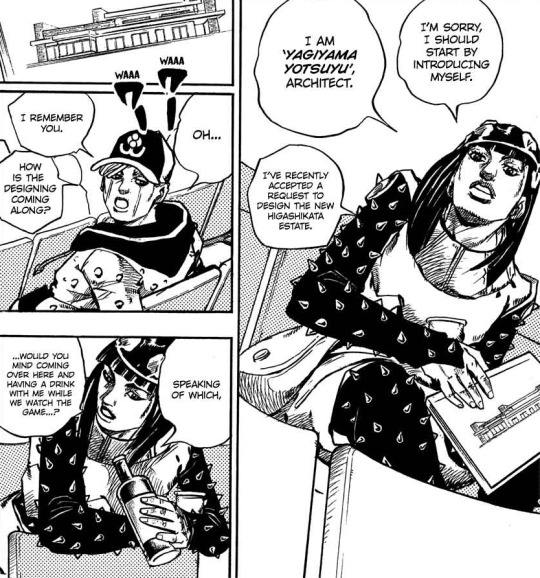
JJL chapter 72: The Northern Higashikata Estate, The Orchard

JJL chapter 49: Hato-chan Brought a Boyfriend Over – part 3
So, the time is still match if Jobin is the one who started cooperating with Damokan group. Even if Caato was the actual perpetrator, shouldn't she was still in prison at the time? Can you guarantee that she can act in the outside world while incarcerated? If we look at her backstory, we don't see her using her Stand at all, so we can assume that she didn't have Stand yet at the time (or that her Stand was useless).
They said that this could be a hint:

I think she just meant: “I was helping your business too, how dare you ignore my merits just because I went to prison?”
Her claim that she also helped the family business running smoothly for 15 years is a hint that relates to smuggling, perhaps because the 15 years she said happened to coincide with the length of time she was in prison. However, this word still have double meaning, it’s still possible that 15 years she meant is the time during her marriage with Norisuke IV prior to her incarceration and divorce. When she got arrested, Jobin was a teenager who was around 15 or older (hm… actually he was 17 at the time).
Even if her 15 years of contribution was done during her time in prison, how is that automatically related to the smuggling of Locacaca? I don’t think that Damokan group started operating as long as 15 years ago, at least there is no hint yet that the Rock Humans (and Locacaca) had been invading Morioh 15 years ago.
Read further:
JoJolion Cardspiracy: Caato and Damokan group
What actually happened in Mamezuku Rai’s past? (chapter 99 spoilers)
”She already got her flashback.”
First, what is the purpose of flashback? Flashback is a literary device in a story that provides some background information on events, situations or a character's past history; flashback’s often used to reveal some important truth about a character's past. Have we ever seen Kaato on a flashback? Yes, on JoJolion chapter 64 “Mother & Child”. What did we get from that chapter? The reason why Caato went to prison. She wanted to cure Jobin of his Rock Disease through Equivalent Exchange without sacrificing her life. When a random boy (who bullied Jobin) was dying (due to Speed King’s attack), that's when the opportunity arrived. Jobin successfully cured and Caato was still alive. Alas a few years later the boy's body was found and Caato became the only suspect (and went to prison).
The question is: who is this flashback about? Certainly Jobin and Caato. But who does this flashback actually belong to? If we look at whose point of view was being used in this flashback, this actually used Jobin’s point of view. How so? Surely this flashback have been told by Tsurugi’s POV. But let's think of it, where did he hear this story from? Certainly from his father who is none other than Jobin. It makes no sense if Tsurugi got this story directly from Caato, Tsurugi is currently 10 years old whereas Caato was incarcerated 15 years ago.
That sounds possible, but are you sure? Unless Tsurugi ever visited her grandma in prison so that Caato got a chance to tell him this story in her version. But I can tell that chapter “Mother & Child” uses Jobin’s perspective. At the beginning of the flashback we saw Jobin and Caato in one location. They were still in the same place until Jobin finally joined the scout group. After that we see how Jobin was bullied by the Boy-scout Bully.
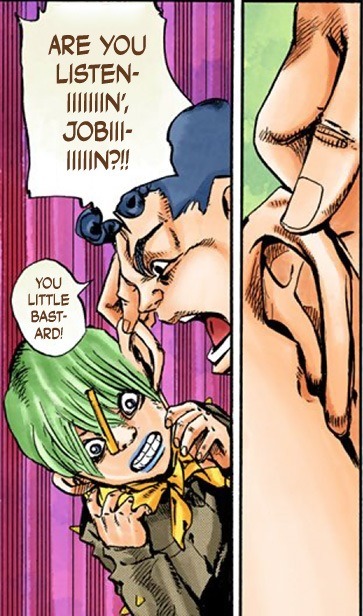
Until finally the bully got attacked by Speed King and Jobin rushed to his house and went to see Caato in a panic. Jobin who was deeply scared and did not know what to do really needed his mother’s help. That's when we see Caato took an action and made her decision to do equivalent exchange for Jobin. Jobin had constantly been seen in this flashback whereas there was moment where we didn't see Caato. We have never seen what she was doing when Jobin was away.
The flashback tells us nothing about Caato or Jobin’s motivations, but it serves well in showing the growth of a certain character. Who is it? Of course it’s Jobin. What we got from Caato is that she wanted to save her son but also wanted to stay alive, she succeeded but had to pay for her action by going to prison, full stop. What we got from Jobin is that this incident and what his mother had done have evoked his ambition, he aspires to do innovation for his family business, expanding the trade, getting rid of his competitors and elevating his family’s social standing, to be on top. Despite her absent for 15 years, Caato is the parent who had the biggest influence on Jobin, becoming what he is today.

If to be a main villain requires flashback, sadly this is not her flashback, this one belong to Jobin. Most people focus on the theme of Stand ability as the main villain pattern. If we really rely on pattern to determine the main villain, we shouldn’t forget the flashback that shows the growth of main villain, aka childhood flashback.
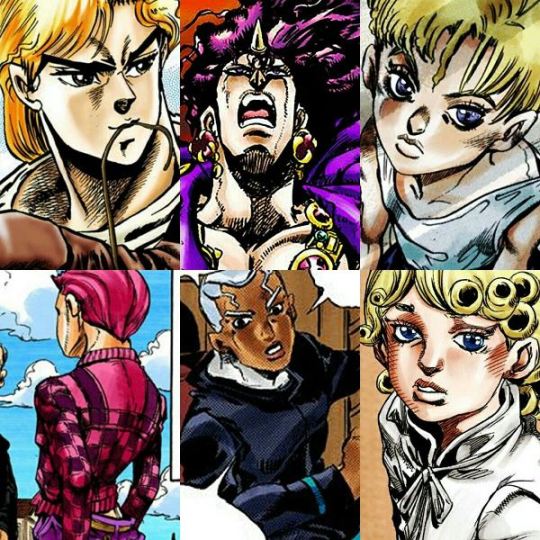
Then, whose childhood flashback did we get in part 8? Of course it’s Jobin, again.

Read further: Caato Higashikata, 34 chapters (8 volumes) MIA and still overhyped
What does Caato really need to be a proper main villain?
Her own motivation which does not depend on anyone and will affect all players on the game
In her case, a motivation that is not shared with Jobin and the motivation/objective that will interconnect with other characters, affecting their actions and in this part 8, it shall be related to the Locacaca.
The Higashikata alimony dispute can’t be the main villain’s objective because that objective will only have an internal impact on the Higashikata family, not on the Head Doctor, Holy’s side and Locacaca Organization. The desire to cure her grandchild Tsurugi which requires Locacaca is also not good enough to be her main villain’s motivation because it more belongs to Jobin. Caato requires motivation that comes from her individually and that is not the kind of motivation "to help muh family."
However, those two motivations/objectives do not devalue Caato as a character, the alimony dispute makes her stand out as a character that has her own motivation and doesn’t depend on other characters. Helping Jobin will make her a very supportive character that's a solid role.
Flashback that really tells about her, preferably her childhood (or at least her origin that is outside the Higashikata)
We still need to know more about her a lot, where was she born from and where was her social standing prior to her married life with the Higashikata? How was her childhood life? Her origin? Why did she marry Norisuke IV? And most importantly what past events caused her to be the individual we know today?
How her current position can work to achieve her goals
Will being an ex-convict and Higashikata widow really help her achieve her goals? If not, is there any other status/position that she is currently hiding?
Further ability of her Stand
We need to know the name of her Stand and what else it can do? Of course she also needs ability that must be very difficult to be challenged to by most Stand users.
How about the other main villain candidates, Head Doctor and Jobin?
Head Doctor Akefu (Tooru?)
The head doctor (which his real identity might be Tooru) already seemingly has a grand objective that sounds grandiose and idealistic. A rock human being, allegedly he was the leader of the Locacaca Organization and the mastermind. Even if it’s false, as The Head Doctor working in T.G. University Hospital, it was clear that he’s holding a high position. His Stand, 「Wonder of U」 is already considered dangerous, seeing how our protagonists are struggling with it.
However, his real identity and his origin as an individual is still unknown, his personal motive is also still in the dark. How about his personality? What things he likes? What is his hobby? His relationship with other characters? Daily habits outside his role as villain?
Even so, slowly but surely, his identity is being revealed. Chapter after chapter increasingly assures us that Tooru will be the actual “Head Doctor” that is undercover. Chapter 99 confirmed that he is a rock-human and also the perpetrator who ruined Rai's family & his life in the past. It's clear that Tooru also wants New Locacaca. It’s also implied that being a rock-human, he is older than he looks, which means that there is still a possibility that we will see his connection with the pasts that have not been revealed yet. We need to see more about him and I’m sure we will, because Araki is putting his focus on Tooru’s character arc right now.
Jobin Higashikata
We already know who he is and are pretty familiar with him, we know what thing he likes, his relationship with his family, and his background is pretty clear. We have seen his flashback, we also have seen plenty enough about Speed King. The motivation is not grandiose and idealistic but very humane, he only cares to his family and it’s always about his family. He has a pretty good standing but his position making his relation with the Locacaca less direct compared to Head Doctor. Although he is my best main villain candidate, he is still a wild card in reality. He is closer to be a villain but there is also possibility that he would be reluctant ally for Josuke.
So how do you see Caato’s role currently?
Despite her relatively small appearance, Araki really wrote her character pretty well. We can see a little of her personality, her little background and her relationship with her family. I’ve seen her own motivation as stand-alone individual. Her character is humane and relatable, wanting to save her son while wanting to stay alive as well. Her character is established based on the mother’s role. Like all mothers, she was willing to sacrifice her life for her son. However, her action makes an interesting contrast to Norisuke IV and his mother, both of them chose to sacrifice their own lives. By sacrificing other people's lives, she might be seen as a selfish person. But perhaps because she had more than one child, she needed to stay alive so that they won’t lose their mother figure too young. Eventually she had to pay for her action by going to prison as another form of her sacrifice. Ironically, her selfish way in saving Jobin made her lose 15 years of mother role for her children. Nevertheless, she readily accepted that consequence.
Caato is the parent who earned Jobin’s respect more than Norisuke IV. Her sacrifice (which Norisuke IV did not do) had a huge influence on Jobin and his growth, her action had shaped him, making him the man we know today. Even at this present time, as a mother, she remains supportive for Jobin by trying to warn him and provide him information as best as she could. Jobin often mentions her positively.
Caato’s portrayal might be largely based on the mother’s role, but her characterization doesn’t always revolve around her being a mother. This is shown by her personal intention who wants half of the Higashikata fortune as the payback for her sacrifice. She wants to take back what's rightfully hers.
Only appeared in a few chapters, Araki successfully wrote Caato as a solid character. As a character with "the mom" role, she is already in relatively high tier compared to the other JoJo moms. Regarding her role against the protagonists, she is still the wild card. We do not know yet whether she will fight them or help them later, what's clear is that she's on Jobin’s side. However, I agree with JoJo wikia which compares her role to Yoshihiro (part 4 Kira’s dad).
How shall we consider Caato’s role right now?
I think we should just wait and see, surely she is an interesting character. There is nothing wrong in wanting a female gets a major role, especially as the main villain. Because so far we have never gotten a female as the main villain in JJBA and this is the era where a lot of entertainment media become "woke" and sided with feminism. However in Caato’s character, her potential to be main villain is still weak and not visible yet, although I feel there is already the potential of her to be a villain. My suggestion is we should treat her as a wild card character for the moment.
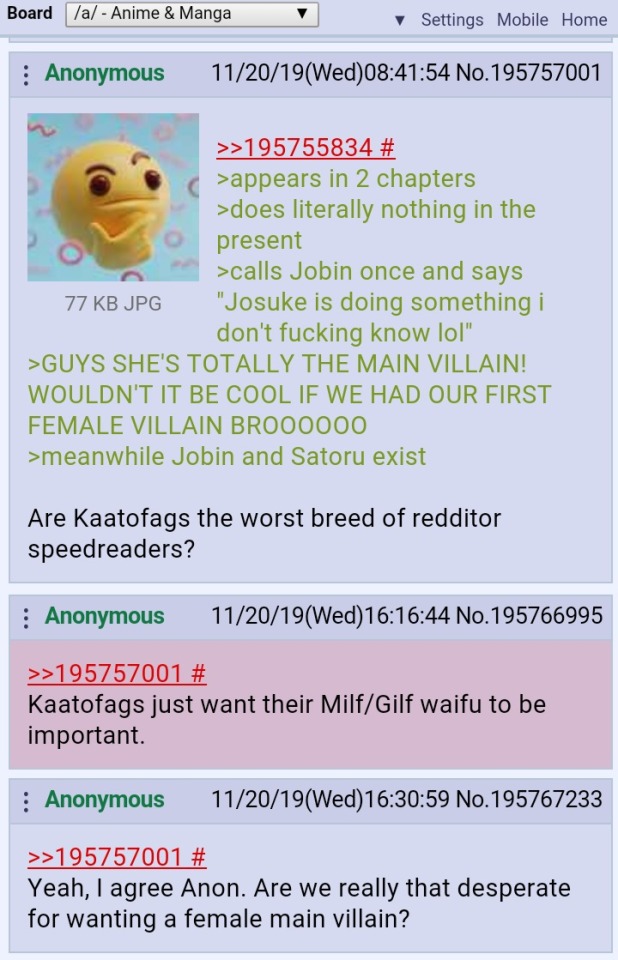
So for those of you who want Caato to be the main villain, please shut up, just wait and see! Stop overhyping her in every JoJo thread that she will be the main villain, at least don't treat her like she already is, especially when JoJolion's focus is on the Head Doctor right now. Sure, I still want to see more of Caato again as I believe that her role is not finished yet.
To be honest, I also want a JoJo main villain to be female, but with how Caato was created and established, I don’t think that she is set to be the main villain. Sure, it's still too early to say, if indeed Araki would make her the main villain, hopefully he could play it correctly. I also want to see a female main villain in JJBA, but I won’t be disappointed if the main villain we get in this part 8 is another man. Because honestly, I don’t want JJBA becomes woke just for the sake being woke by putting political correctness and feminist agenda over the quality of storyline.
Caato are you ok?
So, Caato are you ok?
Are you ok Caato?
They don’t want you
They don’t think you
Will be main villain
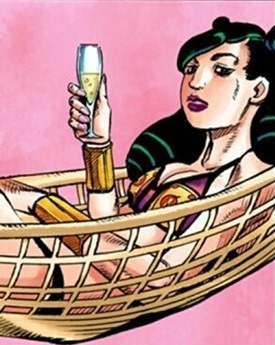
”I’m okay, so what?”
TL;DR: Caato is already a well written character, she doesn’t have to be the main villain to make her standing out and be a prominent character, not being the main villain doesn't make her lack of anything. It’s fine if you hype her as the main villain but we still need to see her further. So please don't tell us that she will definitely become the one as if it becomes a fact. There is still long way to go and we need to see more of her.
See also:
The legit hype Caatofags once had
JoJolion: The Main Villain and The Red Herrings
JoJolion timeline LOG
#kaato higashikata#jojolion theory#jjba main villain#character study#my thoughts#jojolion#jobin higashikata#satoru akefu#tooru jojo#jjba meta#meta post#character analysis#main villain theory#jojo's bizarre adventure#jjba part 8#jojo spoilers#caato#stfu caatofags
13 notes
·
View notes
Text
Dear white people:more than a T.V. show- Review
My first exposure to this three-season show was from a friend. I remember her saying, "it's a great show even though there's a bunch of sex scenes... and it's nothing like the movie,". My original thought after such a comment was, "why watch it then?". I now know after watching all three seasons that this T.V. show is nothing like its movie counterpart. The only similarity is the radio show and them being in a majority white show. The branding of the show should be renamed "Dear everyone,". WARNING SLIGHT SPOILERS
A hypocrite is a person who - but who isn't? - Don Marquis
The show opens similar to the movie but, you are introduced with a new Radio Host, Sam.
Sam and her friend Joelle host a radio show which is all the rage in their all-black dorm. The topic discussed is not typical: a blackface party allegedly hosted by an alt-right satirical newspaper: Pastiche. I assumed this show would be like any black people show commenting on how racist white people are and black people are oppressed however, this show is far from the exception. Sam is mixed and she leans towards her black heritage and almost relinquished her mixed-race in the first season. She is then confronted head-on by this throughout the first and second seasons.
The other main character, Lionel struggles coming to terms with his sexuality and how to integrate into LGBTQ+ society. While doing so he also struggles with his passion for writing as a journalist (and other forms of writing). Joelle tries to find herself outside her intellectual duties and who she is as Joelle not "Sam's friend". The list goes on with every character that appears. No expense is shared when writing these characters they are a mirror not only for the black community but America as a whole. The roster expands with every topic discussed.
A topic that sets it from the original; the dive of hypocrisy. This is the main theme (at least I think so) It starts with Sam's hypocrisy, Joelle's, Reggie's, then Troy's, The black Illuminati ( bro, what?). My favorite hypocrisy discussed was the black community.
My favorite display of this is in season three when they speak of a relevant topic: sexual assault. The scene is set by the characters in BSU playing Mafia. This is symbolic due to them being black and Reggie gaining flashbacks to him having a gun pulled on him. What really makes this symbolic is by every person killed, they are pulled into an argument between Coco and Brooke. a beloved black programming professor, Moses Brown, is accused of sexually assaulting Coco's best friend, Muffy. How the characters react is by the experience each character has prior. For example, Joelle thinks Moses did sexually assault Muffy. Joelle is an Honors Psychology major who is also a black feminist. Based on the treatment she has as a black female it's understandable. Her boyfriend, Reggie, completely dismissed the notion. This also makes sense since he works for Moses, basically worships Moses, and he has a poor experience with white people. Coco is angry with Brooke for even bringing up a topic she had no part in. Brooke is a journalist and was sexually assaulted as a child. All of the characters have experiences that shape their perspective on the matter.
The complex manner of the show isn't made to make the character help you draw conclusions but for you to make your own. I appreciate shows that make you ponder farther. That was a bit of what I noticed but comment in the chat of what you think.
4 notes
·
View notes